News & Announcements
Read the latest news, announcements and events, such as the Tribal Land Staff National Conference, CLE opportunities, land issues, and items in the press about activities of the Indian Land Tenure Foundation and our grantees and affiliates.
Latest News

ILTF IS NOW HIRING FOR THE NATIONAL INDIAN CARBON COALITION PROGRAM
The Indian Land Tenure Foundation (ILTF), a community-based organization with its headquarters located near St. Paul, Minnesota, is hiring for two positions for its National Indian Carbon Coaltion (NICC) program: Carbon Marketing Specialist and Project Manager (Reforestation). NICC is dedicated to combating climate change through carbon sequestration initiatives and innovative reforestation activities.
The Carbon Marketing Specialist will develop and execute marketing strategies to promote carbon-related products, services, and initiatives. This role involves creating compelling campaigns, educating the target audience about carbon-related concepts, and driving engagement to support carbon reduction and sustainability efforts. Click the link for a complete description of the Carbon Marketing Specialist position.
The Project Manager (Reforestation) specializes in developing carbon reforestation projects. The Project Manager will be responsbile for designing, implementing, and managing carbon offset projects that aim to establish and maintain forests and other natural ecosystems. Click the link for a complete description of the Reforestation Project Manager position.
——————————
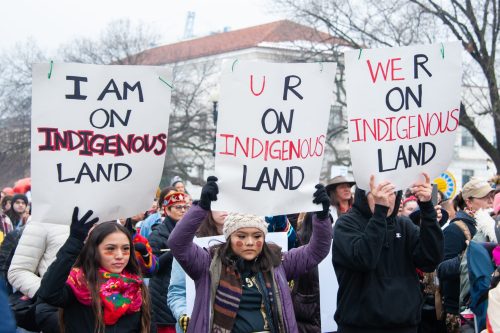
ILTF ANNOUNCES BEYOND LAND ACKNOWLEDGEMENT FUND
Turning empty words into concrete action
Jan. 9, 2023
Little Canada, Minn. — Indigenous land acknowledgements are everywhere now as local governments, universities and other organizations regularly make statements at press conferences, community gatherings and public events acknowledging the historic taking of land by colonial settlers. To many Native Americans, these are just empty words. Now the Indian Land Tenure Foundation (ILTF) is offering those who make land acknowledgements an opportunity to put their money where their mouth is.
“These organizations do the acknowledgement and figure that lets them off the hook,” said ILTF president Cris Stainbrook. “It alleviates their guilt a little I guess. The organization gets nice press coverage, but it never results in any change in behavior or any land back to the tribes. There needs to be some sort of action taken or the land acknowledgement is meaningless.”
In response, ILTF is launching the ‘Beyond Land Acknowledgement Fund’ to serve as a conduit for others – organizations, institutions, governments and the like – to turn talk into action.
Based in the Twin Cities, the Indian Land Tenure Foundation a national, community-based organization that has been serving American Indian nations and people in the recovery and control of their rightful homelands since 2002. It has played a key role in land return projects across the country, including the recent recovery of more than 28,000 acres by the Bois Forte Band of Chippewa.
Spawned by an unexpected gift
Initial funding for the Beyond Land Acknowledgement Fund came to ILTF through an unexpected donation from Holy Trinity Lutheran Church in Minneapolis. Stainbrook spoke to members of the congregation about Indian land issues last fall. When his presentation concluded, the pastor stepped forward to say thank you, read the congregation’s land acknowledgement out loud, and handed Stainbrook an envelope. “She said, ‘Here’s a little something to help you get land back.’ When I opened the envelope I was in shock.” Inside was a check to ILTF for $250,000.
“It blew me away,” said Stainbrook. “It shows that they aren’t just going to church on Sunday to talk about it. They are living their values. This is a community of people who are making a statement. It’s not just one person, it’s the body, it’s the whole. They need to be recognized for taking such a substantial step, for saying, ‘We are serious about this.’”
Many churches have engaged in learning and conversation with Indigenous communities in an attempt to build understanding and bridge longstanding gaps. For Pastor Ingrid Rasmussen and the congregation, there was a need to do more.
“For many years, Holy Trinity Lutheran Church has been publicly saying that ‘We gather on the Dakota Homeland,’” she explained. “More recently, church leaders crafted a longer land acknowledgment that states that the land our congregation currently occupies was taken from the Dakota Nation and other Indigenous peoples through exploitation and violence. Because our church benefited from the land theft, we recognize our responsibility to advocate for treaty rights, tribal sovereignty, and movements to return land back into Indigenous hands. The significance of this sacred ground – as well as its painful history – compels us as a congregation to engage in reparative justice in words and deeds and dollars.”
The donation came with no strings attached, but ILTF is seizing the opportunity to amplify the church’s generosity in a big way. “For those entities that want to put their money where their mouth is there hasn’t been a good vehicle to do that,” Stainbrook said. “To be fair, it hasn’t been easy. They can’t see themselves buying land and returning it. They wouldn’t know where to begin. The ILTF Beyond Land Acknowledgement Fund enables us to collectively pool that money to make purchases. It offers a vehicle for those entities who want to take that next step and actually do something about returning land and making it right.
Media contact: Grant McGinnis (gmcginnis@iltf.org)
Announcements
NEW ILTF WEBINARS
ILTF has webinars coming up in 2023 on a variety of topics. Look for an announcement soon for the first webinar of the year on Jan. 23, 2023.
News Archive
THE BETTER WAY TO RIGHT AN OLD WRONG
Aug. 26, 2022
By Cris Stainbrook
Land that was wrongly taken from tribes more than 100 years ago is often only returned if the tribes agree to adhere to someone else’s interpretation of what’s best for the land. There’s a better way to right an old wrong.
Imagine one day City Hall seized your home’s front and back yards, along with your driveway, front walk and back porch. Yes, you’d still have a house where you could eat, sleep and reside. But you’d no longer have your full home and what was rightly yours.
Now, imagine you were given the opportunity for that land to be returned to you. All you’d have to do is promise to never change a thing. You could maybe do something benign – pruning the trees or mowing the grass – but you could not build a shed, start a garden, or add a swing set for your children.
Would you take the deal?
This, in essence, is the deal Indian Country is commonly offered when land conservation organizations offer to return anywhere from 10 to 10,000 acres of land to Native American tribes. Land that was wrongly taken from tribes more than 100 years ago is often only returned if the tribes agree to adhere to someone else’s interpretation of what’s best
There’s a better way to right an old wrong.
Recently, two organizations, the Indian Land Tenure Foundation and The Conservation Fund, helped finalize a deal by which the Bois Forte Band reacquired 28,089 acres of its reservation land in northern Minnesota that was lost to federal allotment during the late 19th century. This deal is the single-largest private land restoration project in United States and Indian Country history based on available historical data. And that forestland went to the Band without any permanent obligations for the care, management or use of that land.
Some well-intentioned people with an honest desire to see beautiful land remain beautiful challenge this approach. They argue that a lack of permanent restrictions on the land means that trees could be cut down, factories could be built, or lakes could be fished to exhaustion.
But the Bois Forte Band is, and always has been, the best steward of this land. It is their home. It is precious to them, and caring for this land is paramount to them, irrespective of permanent obligations prescribed to them in a legal document, such as a conservation easement.
How do I know this to be true? Through close collaboration with the Band’s leadership, we built an understanding that is centered around listening and fully understanding their unique history, current challenges and vision for the future.
As an example, the Bois Forte Band first sought to safeguard their land by entering into treaties with the United States in 1854 and 1866 to establish a permanent and undisturbed homeland. But a few decades later, the federal government set aside its treaty obligations so it could divide the Band’s land, selling it to timber companies and homesteaders. After The Conservation Fund acquired over 72,000 acres of forest land in 2020 – with significant acreages of allotted reservation land – a unique opportunity took shape to help the Band regain 21 percent of its lost homeland, securing forever what should have been secure 156 years ago.
The Bois Forte Band expressed a unique passion for land conservation and an unquestionable commitment to do what’s best for the forest. Moreover, the Band was prudent in identifying and pursuing opportunities whereby it could financially benefit from keeping the land in its natural state. Acres enrolled in Minnesota’s Sustainable Forests Initiative Act, for example, will generate revenue for the Band.
The transaction further supports the Band’s sovereignty through full-faith-in-credit financing provided by Indian Land Tenure Foundation’s subsidiary, the Indian Land Capital Company, which allowed the Band to acquire the land without having to use it as collateral.
While there was no conservation easement in place on any of the land tracts, the Band was strongly incentivized to maintain these lands as a working forest. This symbiotic mindset goes to the Band’s benefit as much as it secures the forest’s future. In this way, the Band recognizes the forest as an environmental asset rather than a commodity to be consumed.
This arrangement need not be unique. Indeed, an approach that honors tribal sovereignty while incentivizing best practices in land conservation represents a new and gracious path forward for this type of work.
A better way to right this old wrong is by thinking differently. If the people, organizations and financial institutions involved in land restoration work are more willing to structure their deals and finance their transactions differently, we will more readily achieve the outcomes we — tribes and conservation groups — yearn to see.
This is how tribes such as the Bois Forte Band can regain lost land in a way that empowers and inspires – and it’s how we can work together to better right an old wrong.
Cris Stainbrook, Oglala Lakota, has been working in philanthropy for 35 years and has been President of Indian Land Tenure Foundation since its inception in 2002. Before joining ILTF, Stainbrook spent 13 years at Northwest Area Foundation, where he managed grant making programs in sustainable development, natural resource management, economic development and basic human needs.
———————————————-
REQUEST FOR PROPOSAL: AUDITED FINANCIAL STATEMENTS
Aug. 3, 2022
The Indian Land Tenure Foundation (ILTF) is requesting proposals for preparation of its yearly audited financial statements and related information for the 2022 fiscal year ending December 31, 2022. The audited financial statements must be prepared in accordance with generally accepted accounting principles. The audit must also include an expression of an opinion by the auditor on the fairness of financial statements in accordance with generally accepted accounting principles.
ILTF is a 501(c)(3) Minnesota community foundation providing grants and services to federally-recognized Native American Tribes and other organizations working with Native American land issues throughout the United States. We receive funding from individuals, foundations, Native American Tribes and other organizations interested in helping us fulfill our mission. We also pursue funding from the federal government when the opportunity arises. ILTF is also a partner in the Indian Land Capital Company, a for-profit organization which it organized as a subsidiary to provide financial lending services in Indian Country.
ILTF requires the following services:
- Yearly financial audit, including
- Consolidated statement of financial position
- Consolidated statement of activities
- Consolidated statement of functional expenses
- Consolidated statement of cash flows
- Supplemental statements separating parent and subsidiary
- Single audit (if applicable)
- Preparation of IRS form 990
- Preparation of Charitable Organization Annual Report for the Minnesota Attorney General
- Preparation of subsidiary organization’s tax return for applicable states
- Management letter
The final audit report(s) and management letter must be completed within four months of the end of each fiscal year. The tax returns must be completed and filed by August 15. ILTF requires that a meeting of the auditors and selected ILTF staff be held to discuss a draft version of the audit. ILTF also requires that the auditors meet with ILTF’s Audit Committee each May in conjunction with our board of directors’ meeting.
All audit proposals must include:
- Firm’s qualifications to provide the above services
- Background and experience in auditing, particularly of nonprofits
- Size and organizational structure of auditor’s firm
- Statement of firm’s understanding of work to be performed, including tax and non-audit services
- A proposed timeline for fieldwork and final reporting
- Proposed fee structure for these services, with projected costs for future audits covering two additional years, with a maximum fee to be charged
- References from at least three comparable audit clients
Please email your proposal to dbordeaux@iltf.org or mail a hard copy to Indian Land Tenure Foundation, 151 Cty Rd B2 E in St. Paul, MN 55117. Proposals must be received by September 30, 2022. Our Audit Committee will review all proposals and make a recommendation regarding the choice of auditors to our full board of directors in early November.
If you have any questions or would like further clarification of this request for proposals, please contact D’Arcy Bordeaux at 651-789-1742.
———————————————
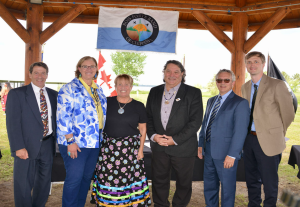
NEWS RELEASE
BOIS FORTE BAND REGAINS HISTORIC TRIBAL LAND
Partnership between Band, The Conservation Fund, Indian Land Tenure Foundation restores ownership of 28,089 acres of reservation land lost more than 100 years ago
NETT LAKE, Minn. (June 7, 2022) — The Bois Forte Band of the Minnesota Chippewa Tribe, in partnership with The Conservation Fund and the Indian Land Tenure Foundation, along with its subsidiary Indian Land Capital Company (ILCC) announced today the completed purchase of land that restores to the Band more than 28,000 acres of land within the Nett Lake and Deer Creek sectors of the Bois Forte Reservation.
The Band’s acquisition of 28,089 acres previously held by timberland owner and lumber manufacturer PotlatchDeltic Corporation constitutes the largest restoration of land since the Nett Lake and Deer Creek sectors of the Bois Forte Reservation were established in Minnesota under the Treaty of 1866. Plans are underway for the Band to directly manage the restored lands under a forest management plan that emphasizes conservation and environmental protection balanced with economic and cultural benefits to the Band and its members.
“This is a historic day for the Bois Forte Band,” said Cathy Chavers, Chairwoman of the Bois Forte Band of Chippewa. “This acquisition represents the largest restoration of land to our Reservation since our ancestors secured what was to be our permanent and undisturbed homeland. This acquisition rights a historic wrong and returns lush forests to the Band to foster and protect in homage to our ancestors and as an inheritance to our future generations. On behalf of the Band, I offer the deepest thanks to all those who made this day possible, especially those at The Conservation Fund and the Indian Land Tenure Foundation, whose efforts have been instrumental in making this historic restoration happen.”
The Band entered into a treaty with the United States in 1854 that set aside a region around Lake Vermilion as a reservation, which was later defined through an 1881 Executive Order. In its 1866 Treaty with the United States, the Band reserved two additional sectors at Nett Lake and Deer Creek to serve as its permanent homeland. However, just 20 years later, the federal government changed course, dividing the Reservation land and selling it to timber companies and homesteaders under the General Allotment and Nelson Acts. PotlatchDeltic eventually came to own significant acreages on the Nett Lake and Deer Creek sectors of the Reservation.
While some land was restored to the Band in 1938 under the Indian Reorganization Act, control of significant swaths of land within the 111,787-acre Nett Lake and 22,927-acre Deer Creek sectors remained out of Band ownership. But an opportunity for the Band to regain 28,089 acres – 21% of the total land base within the Nett Lake and Deer Creek sectors – emerged after PotlatchDeltic sold most of its land in Minnesota to The Conservation Fund in 2020. The national environmental nonprofit acquired over 72,000 acres of forestland, including 28,089 acres within the Bois Forte Reservation (27,565 acres in Nett Lake and 524 acres in Deer Creek). Conversations between the Band and the Fund about the lands within the Reservation began shortly thereafter.
“This outcome honors the heritage of this land by reuniting it with the Bois Forte Band and ensuring its long-term stewardship,” said Larry Selzer, The Conservation Fund’s president and CEO. “As a mission-driven organization, we are focused on creating solutions for naturally and culturally important lands that make sense for the environment and communities. We respect the Band as the best possible caretakers for this forestland and celebrate together this historic milestone.”
The Band’s purchase was financed by the Indian Land Capital Company, a Certified Native Community Development Financial Institution (CDFI) providing alternative loan options to Native Nations for tribal land acquisition projects. ILCC is owned by the Indian Land Tenure Foundation, a national, community-based organization serving tribal nations and people in the recovery and control of their rightful homelands.
“As we work to ensure more Indian lands return to Indian hands, today’s announcement demonstrates a meaningful step on the long journey ahead,” said Cris Stainbrook, President of the Indian Land Tenure Foundation. “We are proud to have helped the Bois Forte Band reach this milestone moment and hope that it inspires many more like it throughout Indian Country. And, it reminds all of us that restoring land to Indian ownership, management and control is more than a hashtag, it is a reality.”
A combination of conservation incentive payments under the Minnesota Sustainable Forest Initiative Act, coupled with other sustainable revenue streams that can be derived from the forest, will allow the Band to fully fund this acquisition and promptly pay off the purchase price. Later, the revenue generated from the land will support the Band’s land acquisition and conservation efforts.
The Bois Forte Band, a federally recognized Indian tribe organized under the Indian Reorganization Act of 1934, has over 3,600 enrolled members. The Band’s governing body is the Bois Forte Reservation Tribal Council. Among its other duties, the Council works to identify opportunities to restore the Band’s historic land base lost to federal allotment policies in order to ensure proper stewardship of those lands, expand economic opportunities. and exercise greater control over the Band’s territory.
The Bois Forte Reservation includes three sectors: Nett Lake, Deer Creek, and Vermilion, which are located in parts of Minnesota’s Koochiching, Saint Louis and Itasca counties. The Nett Lake sector is known for its prolific production of high-quality and hand-harvested wild rice, which is of vital traditional, cultural, and economic importance to the Band and its members.
About the Bois Forte Band
The Bois Forte Band of Chippewa is a federally recognized tribe situated in northern Minnesota. The Band’s governing body is comprised of a five-member Council. The Band delivers government services to over 3,600 enrolled members who are located on-reservation, across the United States, and abroad. The Band provides government services through a variety of departments, including Bois Forte Health Clinic, Human Services, Police Department, DNR, Tribal Court System, Realty, Housing, Enrollment, Public Works, IT services, Accounting, Education and Human Resources. As the owner and operator of the Boys and Girls Club, Fortune Bay Resort Casino, the Y-Store, and the Nett Lake C-Store, the Band is one of the largest employers within its region. You can learn more about the Band by visiting its website at: http://www.boisforte.com/.
About The Conservation Fund
At The Conservation Fund, we make conservation work for America. By creating solutions that make environmental and economic sense, we are redefining conservation to demonstrate its essential role in our future prosperity. Top-ranked for efficiency and effectiveness, we have worked in all 50 states since 1985 to protect more than 8.5 million acres of land across the U.S., including nearly 392,968 acres in Minnesota. www.conservationfund.org
About the Indian Land Tenure Foundation
The Indian Land Tenure Foundation (ILTF) is a national, community-based organization serving American Indian nations and people in the recovery and control of their rightful homelands. ILTF works to promote education, increase cultural awareness, create economic opportunity, and reform the legal and administrative systems that prevent Indian people from owning and controlling reservation lands.
Media Contacts:
- Brian K. Anderson, Bois Forte Band of Chippewa, 218-753-7882, bkanderson@fortunebay.com
- Joshua Lynsen, The Conservation Fund, 301-675-7764, jlynsen@conservationfund.org
- Grant McGinnis, Indian Land Tenure Foundation, 320-808-7825, gmcginnis@iltf.org
Map & Images: https://bit.ly/3GBTERz
Watch a video of the historic ceremony.
This news release was originally published by the Bois Forte Band of the Minnesota Chippewa Tribe and is reshared here with permission.
———————————————-
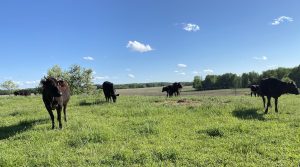
TRIBAL AG EXTENSION PROGRAMS NEED FEDERAL FUNDING BOOST, EXPERTS SAY
Tribal Business News
Jan. 31, 2022
By Chez Oxendine
Little Canada, Minn.-based Indian Land Tenure Foundation has two contracts going with the U.S. Department of Agriculture. The first is to provide legal services, such as will-writing and gift deeds for Native farmers and ranchers. The second is to support the USDA’s Federally Recognized Tribal Extension Programs (FRTEP) and their agents.
FRTEPs serve as tribal parallels to the National Institute of Food and Agriculture’s county extension program, which is administered by land-grant universities and colleges. These programs provide localized agricultural services and research, such as planting information and weather data, to producers in a given area.
While the USDA currently lists nearly 3,000 county extension programs across the United States, only about 30 such FRTEPs exist in territories controlled by the country’s 574 federally recognized tribes.
“We just don’t have the coverage that the rest of the country does,” said Cris Stainbrook, president of Indian Land Tenure Foundation. “FRTEP is so poorly funded compared to the rest of the extension program that when they start talking about tribes participating and working in getting that information out to folks, it’s truly lopsided.”
The inequity presents a problem because tribal extension programs can serve as “lifelines” into communities, said Maureen McCarthy, director of the Reno, Nev.-based Desert Research Institute Native Climate program, a nonprofit climate and environmental research organization.
FRTEP agents often live on the reservations where they work and administer the extension programs, and serve as liaisons to the educational institutions, some of which are tribal colleges and universities. The agents frequently prove themselves to be the best advocates for a community’s needs and issues, according to McCarthy.
“It’s a program that is underappreciated. This is the lifeblood, this is how you hear what the community needs,” McCarthy said. “(The Desert Research Institute) works with FRTEP agents extensively in determining how best to help these communities.”
Having direct insight into a community’s most pressing needs serves as a shortcut through “red tape” that may otherwise delay badly needed aid, McCarthy said. She cited programs prompted by COVID that might have stalled in the bureaucratic process before reaching people in need if not for the local knowledge and community presence of FRTEP agents.
“We started a working group in March 2020, weekly Zoom calls with FRTEP agents from the land-grant universities and tribal colleges we work with. We took those urgent needs straight into USDA and other agencies,” McCarthy said. “We started programs where we just cut through a lot of red tape. We got resources onto the Hopi Reservation when their roads were closed — we got relief packages all the way up to Alaska.”
FRTEP agents positioned in those communities provided localized guidance, McCarthy said, noting each agent serves as a link between the range of agencies and institutions providing assistance and tribal members.
“We couldn’t have done it without these agents,” McCarthy said.
‘Underappreciated and under-resourced’
FRTEPs are funded through four-year competitive grants administered by the National Institute of Food and Agriculture within the USDA. As of this writing, NIFA funds 36 FRTEPs across the country, 33 of which are located on tribal reservations.
Funding for the grants is comparatively tight, especially given the areas in need of coverage. The most recent Congressional appropriations bill allocated $3.2 million in total funding for the FRTEPs. By comparison, Agriculture Secretary Tom Vilsack’s most recent request for county extensions stands at $315 million. While the Cooperative Extension program pays more than 15,000 full-time employees, only 30 or 40 people are employed by FRTEP nationwide. (The USDA did not respond to requests for comment by press time.)
FRTEP was established as part of the 1990 Farm Bill, which outlined a program supported by a $10 million appropriation and a network of 90 agents across the country. However, FRTEPs have never received the initially promised $10 million annual budget, according to a 2016 Indian Land Tenure Foundation report.
Funding for FRTEPs peaked at around $3 million annually in 2005.
As a result of this meager funding, adding an office on a new reservation or territory often forces one to close somewhere else in Indian Country, according to Stainbrook.
Moreover, each agency typically employs one agent, and the funding awarded by each grant serves primarily to cover that agent’s salary and not much else.
“They have to find creative ways to develop their programs,” McCarthy said. “There’s like one agent per reservation, and there’s not 100 percent coverage to all of our communities. Tribal extension, as a whole, has been underappreciated and under-resourced in comparison to the major investments in cooperative extension that’s been made for decades by USDA.”
The lack of coverage delays or even halts the flow of information to participating communities. Farmers use that information for developing everything from planting to grazing strategies, Stainbrook said.
“The USDA talks about county extension programs being ‘key’ to getting information out,” Stainbrook said. “If we don’t have a comparable track in Indian Country, we’ll get that information late or it may never get to the reservation. If they’re key to the other producers, shouldn’t they be key to Indian Country as well?”
Organizations like the Indian Land Tenure Foundation are stepping up to help provide direct funding for agents. For example, Stainbrook said the organization recently purchased a rototiller for one agent. Even so, he acknowledges that private funding won’t be enough to close the gap.
In response, Stainbrook and others are advocating to change the structure of the FRTEP grants to allow for more projects in more territories through a multi-agency commission sponsored by the Native American Agriculture Fund.
“The commission is really to look at the FRTEP program itself going forward and expanding,” Stainbrook said. “It’s really to come up with what we want to see over the next ten, twenty, fifty years, and then begin getting that put into the next Farm Bill.”
The commission’s primary goal is determining how to expand and “uncap” FRTEPs, allowing for an increased budget and expanded employment.
“We want to solidify these existing programs so they don’t go away when someone new applies for funding,” Stainbrook said. “We want these FRTEP agents to have tenure and support the same way cooperative extension agents do.”
The commission, which draws its membership from Native agricultural agencies, FRTEP agents, and a NIFA adviser, wants to see greater equity between FRTEPs and the cooperative extension, which starts with expanding the grants and securing more funding, Stainbrook said.
Although Stainbrook estimates that tribes could use “75-100” FRTEPs to approach parity with county extensions, McCarthy aimed even higher.
“Every tribe in the nation should have a minimum of one extension agent, a FRTEP extension agent or access to an agent” through tribal land-grant colleges, McCarthy said. “This should not be negotiable.”
Each of those potential agents represents a valuable asset for the tribe they’re attached to, which makes expanding the program “critical,” Stainbrook said.
“They’re a committed group of people, more than I’ve ever seen in a lot of places, and that’s what keeps us involved,” he said.
———————————————-
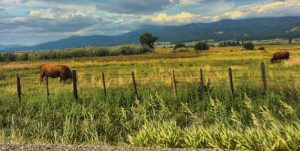
ILTF SELECTED BY USDA TO PROVIDE TECHNICAL ASSISTANCE FOR NATIVE FARMERS AND RANCHERS
Jan. 5, 2022
LITTLE CANADA, MN – The Indian Land Tenure Foundation (ILTF) is one of 20 organizations selected by the U.S. Department of Agriculture (USDA) to provide underserved farmers, ranchers, and foresters with the tools, programs and support they need to succeed in agriculture. The USDA has allocated approximately $75 million in American Rescue Plan funding for this initiative. Organizations, including ILTF, were selected for their proven track records working with underserved producer communities.
Massive amounts of reservation lands that were guaranteed by treaty and executive orders for “the exclusive use and occupation by Indian people” are now owned or leased by non-Indians for agricultural production. The resulting loss to the Indian agricultural economy was estimated at $8.5 billion in 2017 (last year of data availability). This compares to the approximately $1.3 billion generated by Indian farmers, ranchers and tribal operations. Native farmers and ranchers are not just socially disadvantaged but often actively discriminated against in both policy and practice. Even federal policies enacted with good intentions have often resulted in further disadvantaging Indian farmers and ranchers and impeding economic growth.
For nearly 20 years, ILTF has been providing information and technical assistance to Native Nations and individual Indian landowners focused on management and control of their land assets, much of which is agricultural land. ILTF has provided numerous publications, website content, landowner workshops (both on-reservation and online), assistance with Agricultural Resource Management Plans, as well as estate planning services to prevent further fractionation of Indian land. This USDA funding will enable ILTF to do even more.
———————————————-
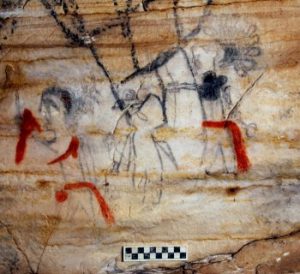
ILTF RAISING FUNDS TO SUPPORT RETURN OF ‘PICTURE CAVE’ CULTURAL SITE TO THE OSAGE NATION
Sept. 13, 2021
Tucked away within a 43-acre tract of woodlands in rural Warren County, Missouri is Picture Cave, one of the most significant cultural and archeological sites in the eastern United States. Today Picture Cave is in danger. The family that owns the property is determined to sell it on the open market and is putting it up for auction to the highest bidder without regard to the history and importance of the site. The cave art is believed to be the work of ancestral Osage peoples who traveled to Picture Cave to carry out sacred rituals, rites of passage and vision quests, to commune with spirits in the “other world” and to bury the dead. Indian Land Tenure Foundation is supporting the Osage Nation’s efforts to reacquire this important cultural site.
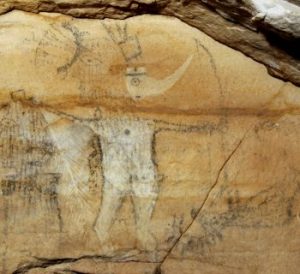 Located just west of St. Louis, this “dark zone cave” (a cave that has no natural light) contains 299 individual pictographs (paintings) grouped into 12 panels on several walls of the cave. Using accelerator mass spectrometric radiocarbon analysis, archeologists have determined that the paintings date back at least 1,000 years.
Located just west of St. Louis, this “dark zone cave” (a cave that has no natural light) contains 299 individual pictographs (paintings) grouped into 12 panels on several walls of the cave. Using accelerator mass spectrometric radiocarbon analysis, archeologists have determined that the paintings date back at least 1,000 years.
Picture Cave is also home to a significant population of endangered Indiana and gray bats that reside in the cave during the winter months. Although the cave entrances have been gated to deter humans from entering, the gates are not designed with access and airflow requirements the bats need to survive. Once the site is back in the hands of the Osage, the Nation will install appropriate bat gates to restrict human access and save the bats.
Working together with The Conservation Fund (www.conservationfund.org), ILTF is helping to raise sufficient funding so that Picture Cave can be returned to the Osage Nation to be protected and preserved forever.
To support these efforts, donors can click here to contribute to ILTF’s Land Recovery Fund. 100 percent of contributions will support the Osage Nation’s reacquisition of Picture Cave.
———————————————-
REQUEST FOR PROPOSAL: AUDITED FINANCIAL STATEMENTS
July 16, 2021
The Indian Land Tenure Foundation (ILTF) is requesting proposals for preparation of its yearly audited financial statements and related information for the 2021 fiscal year ending December 31, 2021. The audited financial statements must be prepared in accordance with generally accepted accounting principles. The audit must also include an expression of an opinion by the auditor on the fairness of financial statements in accordance with generally accepted accounting principles.
ILTF is a 501(c)(3) Minnesota community foundation providing grants and services to federally-recognized Native American Tribes and other organizations working with Native American land issues throughout the United States. We receive funding from individuals, foundations, Native American Tribes and other organizations interested in helping us fulfill our mission. We also pursue funding from the federal government when the opportunity arises. ILTF is also a partner in the Indian Land Capital Company, a for-profit organization which it organized as a subsidiary to provide financial lending services in Indian Country.
ILTF requires the following services:
- Yearly financial audit, including
- Consolidated statement of financial position
- Consolidated statement of activities
- Consolidated statement of functional expenses
- Consolidated statement of cash flows
- Supplemental statements separating parent and subsidiary
- Single audit (if applicable)
- Preparation of IRS form 990
- Preparation of Charitable Organization Annual Report for the Minnesota Attorney General
- Preparation of IRS form 1065 for subsidiary organization
- Preparation of subsidiary organization’s partnership tax return for applicable states
- Management letter
The final audit report(s) and management letter must be completed within four months of the end of each fiscal year. The tax returns must be completed and filed by August 15. ILTF requires that a meeting of the auditors and selected ILTF staff be held to discuss a draft version of the audit. ILTF also requires that the auditors meet with ILTF’s Audit Committee each May in conjunction with our board of directors’ meeting.
All audit proposals must include:
- Firm’s qualifications to provide the above services
- Background and experience in auditing, particularly of nonprofits
- Size and organizational structure of auditor’s firm
- Statement of firm’s understanding of work to be performed, including tax and non-audit services
- A proposed timeline for fieldwork and final reporting
- Proposed fee structure for these services, with projected costs for future audits covering at least two years, with a maximum fee to be charged
- References from at least three comparable audit clients
Please mail your proposal to: Indian Land Tenure Foundation, 151 East County Road B2, Little Canada, MN 55117
Proposals must be received by August 15, 2021. Our Audit Committee will review all proposals and make a recommendation regarding the choice of auditors to our full board of directors in September.
If you have any questions or would like further clarification of this request for proposals, please contact D’Arcy Bordeaux at 651-789-1742.
———————————————-
U.S. DEPARTMENT OF TRANSPORTATION TO HOST TRIBAL LISTENING SESSION MARCH 24
March 9, 2021
The U.S. Department of Transportation will hold a virtual listening session on March 24, 2021 as part of the DOT’s efforts to develop a detailed plan of actions to strengthen the nation-to-nation relationship between the Department and Tribal nations. This effort stems from the Jan. 26, 2021 Presidential Memorandum on Tribal Consultation and Strengthening of Nation-to-Nation Relationships (Executive Order 13175). The Tribal consultation session will be held from 2 p.m. to 3:30 p.m. Eastern Daylight Time. Participants can access the online presentation at www.transportation.gov/self-governance.
Click here to read the Feb. 28, 2021 letter on the subject sent to tribal leaders by Arlando Teller, Deputy Associate Secretary, Tribal Affairs.
———————————————-
DEPARTMENT OF THE INTERIOR PROPOSES CHANGES TO PROBATE REGULATIONS
Jan. 28, 2021
The Department of the Interior (DOI) is updating regulations governing probate of property that the United States holds in trust or restricted status for American Indians. Since the regulations were last revised in 2008, the DOI identified opportunities for improving the probate process.
These proposed revisions would allow the Office of Hearings and Appeals (OHA) to adjudicate probate cases more efficiently. The proposed revisions would also enhance OHA’s processing by adding certainty as to how estates should be distributed when certain circumstances arise that are not addressed in the statute.
The Department will hold a tribal consultation session, a public hearing and provide the opportunity to submit comments. The Indian Land Tenure Foundation encourages Indian landowners to participate in this process.
Important Dates
- Feb. 9, 2021 – A tribal consultation session will be held at 1 p.m. (Central time)
- Feb. 11, 2021 – A public hearing will be held at 1 p.m. (Central time)
- March 8, 2021 – Deadline to submit written comments
Submit comments
You can submit comments in the following ways:
- Via the Federal Rulemaking Portal: www.regulations.gov (The rule is listed under Agency Docket Number DOI– 2019–0001)
- By email: Tribes may email comments to: consultation@bia.gov. All others should email their comments to comments@bia.gov
- By mail or courier: Ms. Elizabeth Appel, Office of Regulatory Affairs & Collaborative Action, U.S. Department of the Interior, 1849 C Street NW, Mail Stop 4660 MIB, Washington, DC 20240
Please note: ILTF is not accepting comments on this proposal. Please use one of the above methods to make a submission.
Click the link below to download a pdf of the Draft Probate Regulations.
Draft Probate Regulations 1.7.21
———————————————-
INDIAN PROBATE WEBINAR: PRESENTER REPONSES TO VIEWER QUESTIONS
On Jan. 14, 2021 the Indian Land Tenure Foundation (ILTF) and the National Tribal Land Association (NTLA) co-hosted the webinar, “Navigating the Probate Process.” The webinar elaborated on the Indian probate process and some of its institutional challenges, along with current and long-term challenges to the probate process overall. The panelists discussed the importance of properly executed wills and their storage, and provided an idea of what happens during a hearing and decisions stemming from it.
The panel included three representatives of the Probates and Hearing Division of the Office of Hearings and Appeals: John R. Payne, Chief Administrative Law Judge (Sacramento, CA); Mary Thorstenson, Acting Supervisory Indian Probate Judge (Rapid City, SD); and Christine Kelly, Supervisory Paralegal Specialist (Albuquerque, NM). The panel was moderated by Nichlas Emmons, Program/Development Officer with the Indian Land Tenure Foundation.
As part of the webinar, viewers were able to submit questions to the panelists who have since provided detailed answers. Click the link below to access a pdf of the Q&A.
Navigating the Probate Process Webinar_Q&A
Click here to watch a video of the entire webinar
Click here to access the presentation slides
Additional questions about the webinar can be directed to Nichlas Emmons of ILTF via email to nemmons@iltf.org.
———————————————-
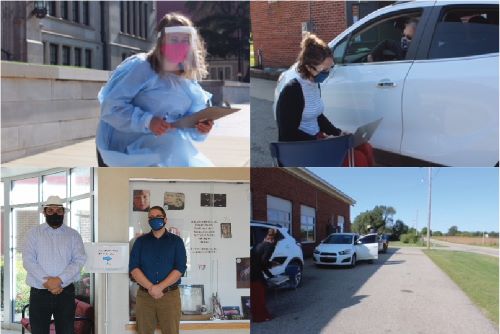
HAVING A WILL HAS NEVER BEEN MORE IMPORTANT FOR INDIAN LANDOWNERS
Dec. 15, 2020
With the COVID-19 pandemic taking a drastic toll across Indian Country, it has never been more important for Indian landowners to have a will. That fact has been driven home by the premature death of so many people in tribal communities, including several who were in the process of writing their wills with assistance from the American Indian Wills Clinic at Oklahoma City University School of Law.
Casey Ross (Cherokee) is Director of the American Indian Law and Sovereignty Center at the University. The clinic provides estate planning services to American Indians in Oklahoma who own an interest in trust or restricted allotment lands. “Our clinic slated several clients for services in the Spring 2020 semester, but due to the pandemic, services were interrupted by closures and restrictions on travel,” Ross explained. “During our hiatus, four of our clients passed away prior to completing their wills, some passing from complications of COVID-19.”
The clinic, which is supported in part by the Indian Land Tenure Foundation and the Oklahoma Bar Foundation, recognized the difficulties that the coronavirus pandemic has presented for clients and took action to resume providing services in a new way. As soon as it was safe, the clinic instituted drive-through services for the execution of wills by Indian landowners.
Adhering to a strict regimen of safety protocols, clinic workers were able to provide services at three different locations in Oklahoma where clients could sign and submit the necessary legal papers to execute wills without having to leave their vehicles. “We resumed services as soon as restrictions were lifted, and put into place protocols designed to keep clients, students, and staff safe,” Ross said. “Our ‘drive-through’ services have been appreciated and embraced. Since resuming services, we have experienced higher demand, and 100 percent of our scheduled clients have shown up for a service date in rural tribal communities. Folks are focused on taking care of this important task during this uncertain time.”
Writing a will enables landowners to determine who inherits their land
For many tribal citizens, their land is the most important thing they own. If Indian landowners pass without a will, however, it is up to a federal probate judge – not the landowner or their potential heirs – to determine who will inherit the land. It often takes years to reach a decision.
This year Indian Land Tenure Foundation (ILTF) introduced a new tool that can make it easier for Indian landowners to have a will. Developed in conjunction with legal services organizations across Indian Country, Will in a Box is now available for American Indians who own trust land in Montana, Minnesota and Oklahoma. Individuals who own trust lands in other states can also use the tool to organize and plan their will prior to consulting with a legal provider in their area. Hosted on the Law Help Interactive web platform, Will in a Box is available free of charge to tribal members.
Click here to learn more about Will in a Box and how it can help tribal members write their will.
———————————————-

ILTF INDIAN LAND APPRAISAL WEBINAR
Nearly every land transaction in Indian Country requires an appraisal but the process can take the Department of the Interior (DOI) many months to complete. The question is why, and what can be done about it?
The Indian Land Tenure Foundation hosted a live webinar on the subject of Indian land appraisals on Oct. 21 which can now be viewed here. The purpose of the webinar is to inform participants about why it is taking so long to get an appraisal completed and to explore recent changes within the DOI’s Office of Appraisal and Valuation Services as well as possible changes in the future. In addition, a portion of the webinar deals with the technical aspects of Indian land appraisal, including probate and valuation, structure and process, and the subject of mass appraisals.
The webinar presenters are Tim Hansen, Director of the Office of Appraisal and Valuation Services (OASV) which is part of the Department of the Interior, and Gregory Powell, who is the Regional Supervisory Appraiser of Navajo/Pacific/Southwest/Western Regions of OASV. The webinar was moderated by ILTF Program/Development Officer Nichlas Emmons.
Click here to view the webinar
Click here to view the presentation slides
————————————————–

ILTF RECEIVES $310,000 GRANT FROM THE BUSH FOUNDATION
Oct. 15, 2020
The Indian Land Tenure Foundation (ILTF) is one of 36 organizations selected by the Bush Foundation to receive an Ecosystem grant, which provide operating support to the programs and organizations that do the most to support the people of the Upper Midwest to creatively solve problems. ILTF has been awarded $310,000 over the next three years.
“The Bush Foundation has been a great supporter of Native organizations and Indian people in the region, and ILTF is grateful to have received a number of grants over the past 15 years,” said Cris Stainbrook, President of the Indian Land Tenure Foundation. “We are pleased to partner with them to advance our mission of returning Indian lands to Indian hands.”
The Bush Foundation’s Ecosystem grants provide operating support for organizations that provide critical data and analysis, spread great ideas and build capacity, advance public awareness and policy, and build and support leadership networks. The grants are awarded through an open application process and grantees are selected based on how the organization operates, its impact on other organizations and leaders, how it fits with the Bush Foundation’s areas of focus, as well as the size of community and organization, demographics and location. ILTF has received four major grants from the Bush Foundation since 2006 totaling more than $1 million.
Based in St. Paul, Minn., the Bush Foundation invests in great ideas and the people who power them in Minnesota, North Dakota, South Dakota and the 23 Native nations that share the same geography. Established in 1953 by 3M Executive Archibald Bush and his wife Edyth, the Foundation supports organizations and people who think bigger and think differently about what is possible in their communities. The Foundation works to inspire and support creative problem solving – within and across sectors – to make the region better for everyone.
————————————————–
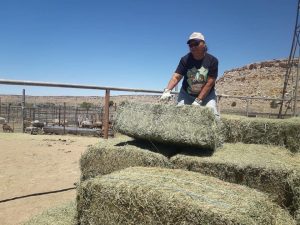
PROVIDING PANDEMIC RELIEF: FRTEP AGENTS ARE PLAYING A VITAL ROLE DURING THE COVID-19 CRISIS
August 24, 2020
Indian Country has been particularly hard hit by the impact of the COVID-19 crisis, but few people have been better positioned to provide assistance than Tribal Extension agents. As local leaders in the Federally Recognized Tribes Extension Program (FRTEP), these individuals have gone to great lengths to respond to the greatest needs on reservations across the country. From distribution of emergency food supplies and protective facemasks to helpful videos on how to make hand sanitizer and successfully grow your own food, extension agents have been a vital resource for Indian people, tribal leaders and government agencies.
Although the numbers are difficult to quantify, there is no doubt that much of Indian Country has been hit harder by the coronavirus than the majority of the nation. The combined impact of poverty, large numbers of individuals with pre-existing medical conditions, and inadequate medical facilities has been devastating.
 “The medical systems are easily overloaded and there have been a lot of deaths,” said Trent Teegerstrom, Director of Tribal Extension at the University of Arizona, whose program serves seven different reservations. “For smaller tribes, the number of deaths has been more impactful as a whole because the population is small and everybody knows everybody. We lost one of our 4-H leaders and the tribes have lost cultural and language people. It has changed the way ceremonies and funerals are done and the people are trying to figure this all out. It’s just a complete paradigm shift.”
“The medical systems are easily overloaded and there have been a lot of deaths,” said Trent Teegerstrom, Director of Tribal Extension at the University of Arizona, whose program serves seven different reservations. “For smaller tribes, the number of deaths has been more impactful as a whole because the population is small and everybody knows everybody. We lost one of our 4-H leaders and the tribes have lost cultural and language people. It has changed the way ceremonies and funerals are done and the people are trying to figure this all out. It’s just a complete paradigm shift.”
Fortunately the FRTEP agents have been able to provide assistance. Some have distributed masks through food banks, soup kitchens and crisis shelters. Others have provided cloth and sewing materials so students in 4-H programs could make masks. At Hualapai there was no hand sanitizer available so FRTEP agents created a video to help community members make their own. Some agents distributed latex gloves and other Personal Protective Equipment (PPE) to tribal communities while others organized the acquisition and distribution of emergency supplies of hay, firewood and food. In Alaska, the Bristol Bay tribal extension program has distributed more than 4,000 meals to youth and 3,000 pounds of produce to elders in remote communities.
“The networks we have with tribes and the USDA (U.S. Department of Agriculture) has been critical, and the relationships that have been built up over time have been integrated into a lot of the efforts taking place,” Teegerstrom explained.
Tribal extension agents have been working in conjunction with government agencies, non-profit organizations and corporations to coordinate logistics for emergency aid to tribal communities. “There has been a lot of collaboration,” Teegerstrom said. “One of the important aspects has been having that one person as a point of contact with the tribes. This situation really highlights the importance of maintaining that.”
Because of the way the FRTEP programs are funded on a two-year cycle of competitive grants, it can be difficult to ensure continuity of programming and personnel. That needs to change, not only to meet the short-term needs created by the COVID-19 crisis but the ongoing needs of the communities, as well. Even during the height of the pandemic response, agents are still serving farmers and ranchers, tribal youth and tribal communities with socially-distant services. Demand for information on how families can grow their own food has been greater than ever, programming for children and teens has been adapted for online delivery, and agents are finding new ways to communicate with stakeholders.
“This crisis has actually brought to life just how critical extension agents and programs are for the tribes,” Teegerstrom said. “We have known for a long time how important it is to have someone in there who has the education and access to the resources that tribes need. Now the USDA and others are finally realizing the importance of that, too.”
————————————————–
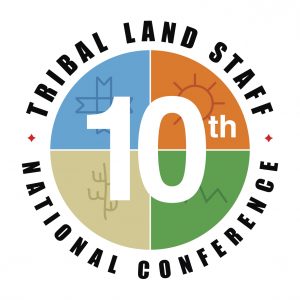
NATIONAL TRIBAL LAND ASSOCIATION, INDIAN LAND WORKING GROUP AND INDIAN LAND TENURE FOUNDATION CANCEL THE TRIBAL LAND STAFF ANNUAL CONFERENCE
March 12, 2020
Due to the rapidly increasing concerns related to the Coronavirus [COVID-19] outbreak, the increasing number of tribes with travel restrictions and the ever-increasing spread of the virus pandemic, the annual Tribal Land Staff Conference scheduled for March 24 through 26 at Mystic Lake has been cancelled. The National Tribal Land Association (NTLA), Indian Land Working Group (ILWG) and the Indian Land Tenure Foundation (ILTF) concluded that it would not be prudent to put attendees, speakers and staff at risk of contracting the virus either at the conference site or in travel to and from the conference.
NTLA, ILWG and ILTF will work together over the next several months to explore ways to share the information from the planned sessions with the conference registrants. ILTF will refund the conference registration fees in full in the very near future. The organizations will explore scheduling dates for the 2021 conference that will allow registrants with airline reservations to take advantage of the one-year grace period offered by some airlines for travel changes.
If you have any questions, concerns or other related issues, please contact Nichlas Emmons at 651-789-1754 or Cris Stainbrook at 651-766-8985.
————————————————–

ILTF ANNOUNCES LAUNCH OF THE TREATY SIGNERS PROJECT WEBSITE
Feb. 12, 2020
In 90 years, the U.S. property system spread across North America from the Atlantic to the Pacific, and the U.S.-Indian treaties were essential events in this remarkable growth. What motivated such aggressive expansion, and who benefited from it the most? That is the question asked by the Treaty Signers Project.
Funded by the Indian Land Tenure Foundation, the Treaty Signers Project opens a surprising new window on the complicated history of US-Indian relations. The men who represented the federal government at treaties were not there by accident. They personified the powerful interests that directly drove the US acquisition of indigenous resources.
The treatysigners.org website presents information on hundreds of U.S. treating signers and on the business, family and social networks that connected them. It also provides basic information on each of nearly 400 treaties, plus stories that show why knowing who signed the treaties is important.
Beyond the American Myth: The real economic forces that drove U.S. expansion
The Treaty Signers Project examines how business interests in land speculation, railroads, the fur trade, mining, forestry and other pursuits heavily influenced the treaty making process and were largely responsible for the loss of so much Indian land. The “American Myth” presents “pioneers” as the driving force of America’s past. By contrast, the Treaty Signers Project presents the economic engines that actually drove U.S. expansion – interests that saw both Indian land and pioneers as sources of personal profit.
The 2,600 men who represented the U.S. in treaty negotiations secured hundreds of millions of acres of land for themselves, their families and their business partners – land that was sold to pioneers at a profit and includes the original sites for hundreds of cities and towns.
The Treaty Signers Project is helping researchers make sense of the vast amount of scattered information on these critical events. This innovative project will foster real discussion about our history as it actually was, not the idealized legends of westward expansion America celebrates today.
Click here to visit the Treaty Signers Project website.
————————————————–

Now hiring: Land Planning Program/Development Officer
Oct. 17, 2019
The Indian Land Tenure Foundation seeks to hire a highly motivated and skilled professional for the position of Land Planning Program/Development Officer.
Reporting to the President of the Foundation, the Land Planning Program/Development Officer will identify, cultivate, solicit and steward program initiatives for American Indian tribes throughout the United States being fully engaged in both programs and fundraising, including but not limited to: the creation and implementation of Foundation programs, grants management, provision of direct services to a variety of clients, development of communication and educational materials, leading the fundraising for each assigned program, reporting to funders of the programs, and measuring the effectiveness of the assigned programs.
Application deadline is Nov. 15, 2019.
Click here to read the complete position description and submit an application.
———————————————————————————
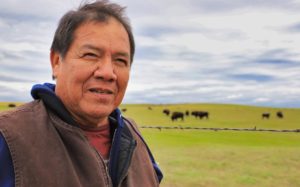
Standing Rock rancher started with nothing, now runs nation’s largest Native-owned buffalo herd
This article appeared in the Oct. 14 edition of the Fargo (ND) Forum
October 16, 2019
BULLHEAD, S.D. — A punishing winter piled up snow on Ron Brownotter’s pastures so high that half of his cattle starved because they couldn’t graze the frigid, windswept prairie surrounding the Grand River. A four-day blizzard stacked drifts as tall as a house, blocking roads to his pastures during the winter of 1996-97. “That changed everything for me,” he said. “I knew I had to diversify from beef cattle.”
The hard lessons from that disaster helped persuade Brownotter to switch to raising buffalo, the rugged “Monarch of the Plains” that adapted to thrive in the unforgiving environment of the Dakota prairies. “They take care of themselves,” he said. “They’re hardy; they’re strong.”
Today, the Brownotter Buffalo Ranch on the Standing Rock Indian Reservation sprawls over 20,000 acres, home to a herd of 600. His herd is part of a buffalo resurgence at Standing Rock that also includes native herds owned by the tribe and others.
For Brownotter, raising buffalo isn’t merely about practicalities. It’s about his ancestry and identity, an extension of the days when the Standing Rock Sioux were sustained by buffalo herds that once roamed the Northern Plains by the millions. “I’m raising buffalo because I’m a Lakota-Yanktonai person on Standing Rock,” he said. “We’re surviving here. It’s who we were and who we are.”
Thanks to years of hard work, Brownotter is doing much better than surviving. His operation is believed to be the largest buffalo ranch solely owned by an American Indian in the United States and Canada, according to the National Bison Association.
It took years of struggle and help from financial partners to survive a gauntlet of challenges. When he started ranching more than 20 years ago, he was commuting from California, where he was attending college, and had to scrounge for posts to build a fence to hold his herd. “I started with nothing,” he said.
***
The roots of the Brownotter Buffalo Ranch span three generations. When many families at Standing Rock were forced to sell their land allotments, his grandmother bought 320 acres in 1917.
“She never sold out,” he said, referring to his grandmother, Annie Leaf. His ranch southwest of Bullhead in Corson County occupies an area called Leaf Crossing.
The parcel his grandmother bought, later inherited by his father, became the basis for Brownotter’s ranch when he got his start in 1994. He eventually bought the land from his family and gradually added more rangeland through leases and purchases from neighbors.
Brownotter’s father raised a small number of cattle, planted a large garden and leased pastureland to neighbors. They also hunted to keep food on the table. “A lot of times we went hunting deer on horses,” he said.
Growing up around cattle — and living in the midst of a sea of grass — imbued Brownotter with a strong urge to raise livestock at an early age.
“I knew I was going to be a rancher since I was 12 years old,” he said. “As a young person I would come out here and fix fence, on my own, without being told.”
He spent money that fell into his hands on items including a shovel and ax, which he regarded as investments in his future. “I knew I needed tools to become a rancher,” he said.
In 1994, while studying agriculture at Cal Poly in Pomona, Calif., Brownotter plunged into the cattle business with the purchase of 100 beef cattle using a loan from a federal loan program.
Whenever he could break away, he made the 1,500-mile commute, one way, back home to Standing Rock to tend his cattle. Family and friends helped when he was away, but being so far from his livestock nagged at him. “It was a constant worry,” Brownotter said. Also, he added, “My equipment wasn’t up to par.”
While at Cal Poly, as a class assignment on agricultural entrepreneurism, Brownotter persuaded his study group to draft a business plan for a buffalo ranch on Standing Rock. The idea was viable, but it would be years before he would pursue it.
A setback in his early ranching days came when he was denied a loan to build pasture fencing. Years later, Brownotter would join a class action lawsuit by American Indian farmers and ranchers alleging loan bias by the U.S. Department of Agriculture.
He had already started building the fence, but had to rip it out. Then came the killer winter.
The impetus to turn to buffalo ranching came in 2000 or 2001. Brownotter and his wife, Carol, were out for a quiet drive to Bullhead. Carol, who was taking classes at Sitting Bull College, knew that it would be a good time to switch to buffalo. “I noticed buffalo prices were at a slump,” she said. The cattle losses in 1997 remained a painful memory, and she knew Ron had yearned to raise buffalo for years.
“I just felt that this was the time to make the change,” she said. “I just said it — ‘We should go into buffalo.’ ” It didn’t take Ron long to answer. “OK,” he said. “I’ll do it.”
That November, the Brownotters went to Custer State Park in the Black Hills for the annual buffalo auction, where they bought six buffalo yearlings. Brownotter fenced off 10 acres near their home.
They were buffalo ranchers.
“That was an amazing feeling,” Carol said.
Click here to read the original online version of this article and view video of an interview with Ron Brownotter.
———————————————————————————
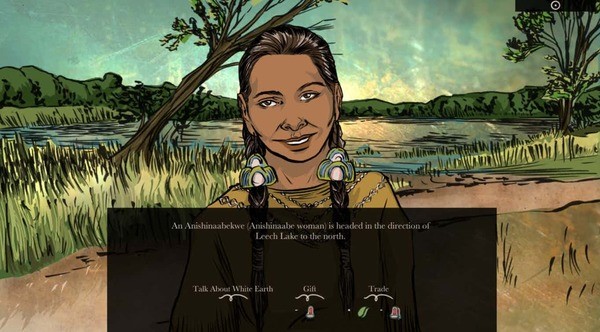
When Rivers Were Trails receives prestigious award at the International Festival of Independent Games
October 16, 2019
St. Paul, Minn. – The International Festival of Independent Games – or IndieCade as it is often called – has selected the When Rivers Were Trails video game as the winner of its Adaptation Award, which honors “works that reimagine how a well-known tale, genre or system can be explored within the context of play.” The honor was given during Indie Cade, which was held October 10-12 in Santa Monica, California.
Developed by the Indian Land Tenure Foundation in collaboration with Michigan State University’s Games for Entertainment and Learning Lab, When Rivers Were Trails is an accessible, educational 2D adventure game that teaches young people about an important and often overlooked period of time in United States history.
Developed with support from the San Manuel Band of Mission Indians, the game follows an Anishinaabeg in the 1890’s who is displaced from Fond du Lac in Minnesota to California due to the impact of allotment acts on Indigenous communities. Players are challenged to balance their physical, emotional, mental, and spiritual wellbeing with foods and medicines while making choices about contributing to resistances, as well as trading with, fishing with, hunting with, gifting, and honoring the people they meet as they travel through Minnesota, the Dakotas, Montana, Idaho, Washington, Oregon, and eventually must find a place to call home in California. The journey can change from game to game as players come across Indigenous people, animals, plants, and run-ins with Indian Agents. Gameplay speaks to sovereignty, nationhood, and being reciprocal with land.
Released in 2019, When Rivers Were Trails is available for PC/MAC, iPads, Android tablets and Chromebooks. More than 20 indigenous writers were tapped in the development of the game, bringing their valuable experience and perspectives to the project.
The game features creative directing by Nichlas Emmons, creative directing and design by Elizabeth LaPensée, art by Weshoyot Alvitre, and music by Supaman and Michael Charette. Indigenous writers include Weshoyot Alvitre, Li Boyd, Trevino Brings Plenty, Tyrone Cawston, Richard Crowsong, Eve Cuevas, Samuel Jaxin Enemy-Hunter, Lee Francis IV, Carl Gawboy, Elaine Gomez, Ronnie Dean Harris, Tashia Hart, Renee Holt, Sterling HolyWhiteMountain, Adrian Jawort, Kris Knigge, E. M. Knowles, Elizabeth LaPensée, Annette S. Lee, David Gene Lewis, Korii Northrup, Nokomis Paiz, Carl Petersen, Manny Redbear, Travis McKay Roberts, Sheena Louise Roetman, Sara Siestreem, Joel Southall, Jo Tallchief, Allen Turner, and William Wilson, alongside guest writers Toiya K. Finley and Cat Wendt who contribute African American and Chinese experiences.
———————————————————————————
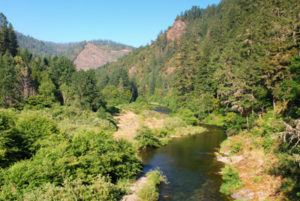
Cow Creek Reservation (Photo courtesy of State of Oregon)
When public lands become tribal lands again
This article appeared in the August 16, 2019 edition of High Country News
By Anna V. Smith
The smell of scorched soil and burnt wood filled the air. Michael Rondeau, CEO of the Cow Creek Band of Umpqua Tribe of Indians, looked over the damage, clad in forest-green pants and a lemon-yellow jacket with “Douglas Forest Patrol” on the back. The Milepost 97 Fire, which started just days earlier with an illegal campfire, had consumed almost 13,000 acres in southwest Oregon. Almost a quarter of that was on the Cow Creek Band of Umpqua Tribe of Indians Reservation — land so recently acquired by the tribe from the Bureau of Land Management that no conservation work or logging had yet occurred.
The tribe lost a good stand of timber, and officials estimate that replanting and recovery could take millions of dollars. Less than two months earlier, I had visited this tract of land, touring it with Rondeau and Tim Vredenburg, Cow Creek director of forest management. Then, it had been lush with evergreens and wildflowers — lupine, beargrass and paintbrush. Now, that was all gone.
“We’ve been so focused on managing to prevent fire,” Vredenburg told me over the phone, a few days after the fire. “That’s where all of our mental energy was being invested in: How do we manage this forest to prevent fire? And doggone it, now we’re looking at: How do we manage it after fire?”
The answer may lie in something Vredenburg and Rondeau said to me before the fire: that the Cow Creek lands would be managed differently now than they were by U.S. agencies prior to their return. Thinning and reintroducing fire through prescribed burns, they told me, would be a top priority for the more than 17,000 forested acres the tribe received through the Western Oregon Tribal Fairness Act in 2018. Rondeau explained that the management of Cow Creek Band of Umpqua Tribe of Indians reservation lands would reflect Indigenous values: an example separate from either industry or conservation groups. “We don’t believe in locking up the forests and allowing them to ‘remain natural,’ because it never was,’” Rondeau said. “For thousands of years, our ancestors used fire as a tool of keeping underbrush down, so that the vegetation remains healthy and productive.”
Looking down from Canyon Mountain at a valley full of blackened madrones and pines, Rondeau and Vredenburg — along with some 1,800 Cow Creek tribal citizens — are thinking of the future, 165 years after their lands were taken and only one year after they were partially returned. The Western Oregon Tribal Fairness Act’s passage illustrates just how long it can take — and the kind of political will it can require — to hold the United States and its citizens accountable for illegal treaty violations.
The journey to regain control of Cow Creek lands has been a long one. In 1853, six years before the state of Oregon existed, the Cow Creek Band of Umpqua Tribe of Indians signed a treaty with the U.S. government. In exchange for a reservation, housing and health care, the Cow Creek ceded 800 square miles of land. But instead of complying with the terms of its treaty, the federal government sold Cow Creek lands to settlers through the Donation Lands Claim act, making the tribe landless. In 1932, Congress passed a bill to restore the tribe’s land base, only to see it vetoed by President Herbert Hoover. Litigation followed. “That really did set back our tribal members for quite a few decades,” Rondeau says. “There was a continuation of their lifeways, but the longer it went from the time of the treaty, they would lose more and more of their culture or just simply be blended in to the new life ways and assimilate.”
But last year, the Cow Creek made a breakthrough with the Western Oregon Tribal Fairness Act. The act — which passed the U.S. House seven times, only to die each time in the Senate — finally was signed into law by President Donald Trump. It restored more than 17,000 acres of public land to the Cow Creek Band, along with nearly 15,000 acres to the Confederated Tribes of Coos, Lower Umpqua and Siuslaw Indians.
“This is pretty rare. It shouldn’t be, but it is,” says Cris Stainbrook, president of the Indian Land Tenure Foundation, of the restoration act. “Those are the homelands of the tribe — these are lands that were reserved by the tribe in the treaty process.”
The Milepost 97 fire, then, was particularly devastating as a pointed reminder of the tribe’s long pursuit of land. During the Termination Era, which started in 1954 and affected tribal nations across the U.S., the federal government terminated 61 western Oregon tribes, abdicating its legal responsibility to Indigenous communities. (To date, five tribes in western Oregon have regained their federal status.) In the 1950s, former Oregon Gov. Douglas McKay, who headed the Interior Department, “enthusiastically” supported termination, after pushing state-level policies to “integrate the Indians into the rest of our population.”
Michael Rondeau represents one of the last generations of Cow Creek to remember what termination was like: no access to higher education or health care, and no land base — despite legal promises. His father, Tom Rondeau, the descendant of French traders and Umpqua people, grew up with a ramble of cousins on his grandparents’ Tiller, Oregon, homestead in the 1940s, hearing a mix of English, French and Chinuk Wawa, also known as Chinook Jargon. Tom, a big guy with a flattop, raised Michael and his brother in Glide, Oregon — 17 miles from where Michael now lives and works. The Rondeaus were a timber family, and Michael spent his childhood summers on the meandering North Umpqua River, a self-proclaimed river rat. By age 17, his dad had him setting chokers on Douglas fir trees to make sure he understood the hard labor he’d be doing if he chose to work in the timber industry.
Decades after termination, persistent efforts by tribal nations and advocates resulted in the federal government once again recognizing tribes and treaty obligations. In the 1970s and ‘80s, the Confederated Tribes of Siletz Indians and the Confederated Tribes of Grand Ronde gained federal recognition again, along with some lands. The Coquille Indian Tribe, Cow Creek and Coos were re-recognized, too, but without lands. Efforts by tribes in what is currently western Oregon to reacquire their land came shortly after recognition.
In 1996, the Coquille Indian Tribe, based on Oregon’s southern coast, regained 5,400 acres of BLM land. But local voters opposed the transfer by nearly 5 to 1 in an advisory vote, and the final legislation required that the tribe allow public access for hunting, recreation and fishing.
An attempt by the Confederated Tribes of Coos, Lower Umpqua and Siuslaw Indians to acquire federal lands the next year in 1997 hit a roadblock when voters and environmental groups vocally opposed the transfer, arguing that the land would no longer be subject to federal environmental law, despite promises from the tribal chairman that the tribe would adhere to federal standards. “Although the Coos tribe still hasn’t formulated details such as the amount of acreage or specific parcels of land,” a 1997 Associated Press article wrote, “environmentalists already say they would oppose any plan that would remove federal land from public control.” The Coos tribe would not receive their lands for another 21 years, until the Western Oregon Tribal Fairness Act.
In 2013, when the Cow Creek drew up plans for the BLM land transfer, Oregon Sen. Ron Wyden’s office nixed the deal. The lands were ground zero for the timber wars of the 1990s, when the Endangered Species Act and industry clashed over the spotted owl, making their transfer almost 20 years later a non-starter for conservation groups. “It was such a touchy conversation with the environmental community — it would have been a complication that would have been hard to overcome,” Rondeau said. Instead, the tribe received BLM lands of relatively lower timber quality — checker-boarded lands, instead of the contiguous land base of many reservations.
The tribe also tried a less conventional approach. In 2017, the Cow Creek Tribe made a bid to buy Elliott State Forest, after the state of Oregon put it up for sale. The Elliott, which was legally required to make money for Oregon schools, hadn’t been producing enough. “Our tribal leadership was concerned that some out-of-state, out-of-the-area or foreign-owned company could come in and buy this forest,” Vredenburg said. With its $220 million price tag, the Elliott was out of reach, so the Cow Creek turned to Lone Rock Resources, a local Oregon-based timber company.
Conservation groups, critical of Lone Creek’s forestry practices, staunchly opposed its involvement and accused the partnership of wanting to privatize the forest. Conservationists in turn were called out for their failure to work with tribal nations: “Your organization has mobilized opposition to the sale, with little to no engagement with the Tribes who would have, once again, become the stewards of this land,” a consortium of racial justice groups, including NAACP Portland, wrote in an open letter to the Sierra Club, Cascadia Wildlands and four other conservation organizations. “We also note the many ways in which environmental groups in Oregon remain predominantly white, and work from a place of white privilege; this situation is a very clear example of the lack of racial justice analysis applied to what is a complicated situation.” Then-Sierra Club Oregon Chapter Director Erica Stock responded, “As an environmental conservation community, we must do more to proactively reach out to Tribal Nations and rebuild trust.”
Ultimately, the sale was dropped by the state after intense public outcry, but tensions between conservation groups and tribes remain.
“The conservation movement began as a way for settlers to justify the seizure of Indigenous lands under the pretext that Native peoples didn’t know how to manage them,” says Shawn Fleek, Northern Arapaho, who is director of narrative strategy for OPAL Environmental Justice Oregon. “If modern conservation groups don’t begin their analysis in this history and struggle to address these harms, it becomes more likely they will repeat them.”
Rhett Lawrence, conservation director for the Sierra Club’s Oregon chapter, says that his group opposed the timber company and privatization, not the concept of tribes regaining their lands. Still, Lawrence acknowledges, “We need to do better about having those conversations. We certainly have not resolved things from where they were two years ago.” Since then, two groups named in the open letter, Trout Unlimited and Wild Salmon Center, have now partnered with the Cow Creek Tribe on restoration projects.
Once a decade, a national study of tribal forests is conducted to monitor land health, production and management. The latest study, in 2013, found that the federal government was not fulfilling its trust responsibility to fund tribal forestry programs, yet noted that tribal stewardship could nonetheless serve as a model for resource management and practices on federal lands. “Those studies have shown that Indian forest management is superior than BLM and BIA because of the direct tie the Indian people have to the land,” says George Smith, chief forester for the Bureau of Indian Affairs from 1978 to 1983 and the former executive director for the Coquille Tribe. “That’s their homeland, so they have a lot more vested interest in how those lands are managed.”
Tribes are often better at managing timberland holistically, says Smith, adding: “The tribal capacity with most of the tribes now, particularly the self-governance tribes, is at least equal to or better than the federal government.”
On a chilly December night in 2018, Michael Rondeau learned that the Western Oregon Tribal Fairness Act had passed. He had been driving through Medford, Oregon, when the call came from Sen. Wyden’s office. After hearing the news, he sat in his car in a parking lot, feeling drained. The Cow Creek would have at least some land back, roughly 3% of what was originally ceded, the result of decades of letter-writing, lobbying, and compromising. “I was of course proud of my team, and the effort that we had accomplished. I was excited for the future and knowing what it would mean to our people,” Rondeau says now. But the sense of victory was inextricably linked with the feeling of injustice that the act sought to correct. “Probably most emotional for me was the sadness that my grandparents and great aunts and uncles and beyond that didn’t have a day of recognition.”
He thought of his great-aunt, Francis Rondeau Corder, whom they had cared for, ferrying her from her mobile home to doctors’ visits that they had to pay for out of pocket, since the promised federal medical care never materialized. She passed before the tribe was recognized. He’d seen the legislation go through the House seven times since 2012, only to die in the Senate, victim to horse-trading and the hazards of Congress.
While the Western Oregon Tribal Fairness Act received less public pushback than the land conveyances of the 1990s and the Elliott debacle, some hard-line environmentalists continue to oppose the return of public lands to tribes. Al Runte, a Seattle-based environmental historian, wrote in National Parks Traveler in January that “had we protested the Western Oregon Tribal Fairness Act, they would have called us racists.” Meanwhile Andy Kerr, who worked for two decades at Oregon Natural Resource Council (now Oregon Wild), still objects to public lands becoming tribal lands. “The Democrats who supported this legislation came down on the side of Native Americans and, in this case, against nature,” Kerr wrote in a December 2018 post on his website.
While “Native Americans” should get some form of compensation, Kerr argued that “such compensation should not come at the cost of losing federal public lands of benefit to all Americans.” Both Runte and Kerr see money as an adequate substitute despite treaty law, since “in the society that won out in that struggle for a continent, the most common way to right wrongs is by money being transferred to the aggrieved parties from the parties that unjustly benefited.” Kerr continues: “The currency of compensation by the United States to Native American tribes ought to be the currency of dollars, not that of the irreplaceable and precious public lands that belong to all of us.”
But it’s not a matter of money, says Cris Stainbrook, Oglala Lakota, of the Indian Land Tenure Foundation. “It’s ironic they don’t recognize they’ve had the public benefit of lands for on the order of 165 years of using someone’s land that was guaranteed to them, and used those lands to their own benefit. It’s about time, after 165 years, that they live up to the treaty.”
Stainbrook says he and others at the foundation often hear arguments like these against tribes working to regain land. Often, opponents say that too much time has passed — that broken treaties, while unfortunate, are a relic of the past. “The same could be said of the U.S. Constitution — why bother with any of that, that was done in the 1770s,” Stainbrook says. “I could quit paying my house mortgage tomorrow, since I signed that nearly 20 years ago. Time isn’t the issue here.”
The Milepost 97 fire started a mile south of Canyonville, Oregon, on July 24, then spread to an old burn scar from the 1980s that was, at the time, BLM land, and is now Cow Creek again. Nine firefighters were injured over five days as snags 100 feet in front of the fire ignited from the embers, “lighting up like roman candles,” recalled Vredenburg.
Recovery from fire means different things depending on the time scale, but with the fires still burning, it’s difficult to think too far ahead. “The irony of finally, after 165 years, getting the reservation that was promised in the treaty, only to have almost a quarter of it burned, it’s gut-wrenching,” Rondeau told me from his office in early August. Still, he talks about the importance of beginning the hard work now, to be carried on for generations of Cow Creek: “I was taught that land was forever.”
The cream-colored beargrass, purple lupine and red paintbrush wildflowers will return within the next few years, and in a few decades, mature pines. But the legacy of fire and its scars will always be there, under the heights of evergreens.
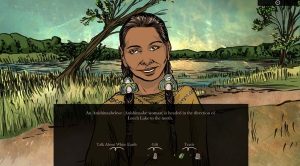
ILTF releases new educational video game on Indigenous history
April 11, 2019
St. Paul, Minn. – The Indian Land Tenure Foundation is excited to announce the release of a new educational video game that teaches about the impact of allotment acts on Indigenous peoples in the 1890s. Available on PC/MAC, iPads, Android tablets and Chromebooks, When Rivers Were Trails is an accessible, educational 2D adventure game that will help teach young people about an important and often-overlooked period of time in United States history.
When Rivers Were Trails was developed by ILTF in collaboration with Michigan State University’s Games for Entertainment and Learning Lab thanks to support from the San Manuel Band of Mission Indians. The game follows an Anishinaabeg in the 1890’s who is displaced from Fond du Lac in Minnesota to California due to the impact of allotment acts on Indigenous communities. More than 20 indigenous writers were tapped in the development of When Rivers Were Trails, bringing their valuable experience to the project.
Players are challenged to balance their physical, emotional, mental, and spiritual well-being with foods and medicines while making choices about contributing to resistances as well as trading with, fishing with, hunting with, gifting, and honoring the people they meet as they travel through Minnesota, the Dakotas, Montana, Idaho, Washington, Oregon, and eventually must find a place to call home in California.
The journey can change from game to game as players randomly come across Indigenous people, animals, plants, and run-ins with Indian Agents. Gameplay speaks to sovereignty, nationhood, and being reciprocal with land. When Rivers Were Trails is available for download on PC and Mac, Apple’s AppStore and the Google Play Store.
The game features creative directing by Nichlas Emmons, creative directing and design by Elizabeth LaPensée, art by Weshoyot Alvitre, and music by Supaman and Michael Charette. Indigenous writers include Weshoyot Alvitre, Li Boyd, Trevino Brings Plenty, Tyrone Cawston, Richard Crowsong, Eve Cuevas, Samuel Jaxin Enemy-Hunter, Lee Francis IV, Carl Gawboy, Elaine Gomez, Ronnie Dean Harris, Tashia Hart, Renee Holt, Sterling HolyWhiteMountain, Adrian Jawort, Kris Knigge, E. M. Knowles, Elizabeth LaPensée, Annette S. Lee, David Gene Lewis, Korii Northrup, Nokomis Paiz, Carl Petersen, Manny Redbear, Travis McKay Roberts, Sheena Louise Roetman, Sara Siestreem, Joel Southall, Jo Tallchief, Allen Turner, and William Wilson, alongside guest writers Toiya K. Finley and Cat Wendt who contribute African American and Chinese experiences.
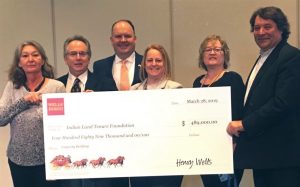
Wells Fargo Grant Helping Native Nations Improve and Support the Operation of Their Tribal Land Offices
April 1, 2019
St. Paul, Minn. – Land is critical to issues facing American Indian people as they pursue economic development, financial independence, and the preservation of their culture and history. The Indian Land Tenure Foundation (ILTF) is committed to serving Native nations in the recovery and control of their rightful homelands. With a new $489,000 grant from the Wells Fargo Foundation, ILTF will be able to continue to help tribes improve and support the operations of their tribal land offices through its National Tribal Land Office Initiative.
“Tribal Land Offices play an integral role in their communities and economies,” said ILTF President Cris Stainbrook. “ILTF intends to build a movement in Indian Country based on the recovery of Indian land and building the capacity of tribal land staffs is key to that objective. To that end, ILTF envisions a network based not only on elevating the capacity of individuals working in tribal land offices, but also on ILTF’s capacity to better serve its constituents by working on a regular basis with an energized network of tribal land professionals.”
Through the grant funding over the next two years, the four components of ILTF’s National Tribal Land Office Initiative – the National Tribal Land Association, the annual Tribal Land Staff National Conference, the Online Tribal Land Office Professionals Certification Program, and Tribal Land Office Summer Internships – will continue to grow and facilitate ILTF’s access to that dynamic network.
Wells Fargo Foundation has awarded nearly $13 million to nonprofits supporting American Indian and Alaskan Native Communities as part of a five-year, $50 million commitment to expand its focus on tribal philanthropy. The grant award recognizes ILTF as a Native non-profit serving critical needs in Indian Country, and was made to help build ILTF’s organizational capacity and expand services.
“We hope our grant to Indian Land Tenure Foundation will significantly expand their important work in improving and protecting tribal lands,” said Cora Gaane, senior vice president and national tribal philanthropy leader at Wells Fargo. “The funding enables them to assist tribes with economic development, land use planning and training and internships for managing land and natural resources.”
ILTF is a national, community-based organization that works to promote education, increase cultural awareness, create economic opportunity, and reform the legal and administrative systems that prevent Indian people from owning and controlling reservation lands. As a community foundation, ILTF accepts contributions from foundations, tribes, corporations, organizations and individuals to support its grant making and program initiatives.
Since its inception in 2002, ILTF has provided more than $45 million in grants, loans and program services in support of Indian land recovery and management. The Foundation makes a positive impact on the lives of Native Americans through a variety of innovative programs and initiatives like its National Tribal Land Office Initiative.
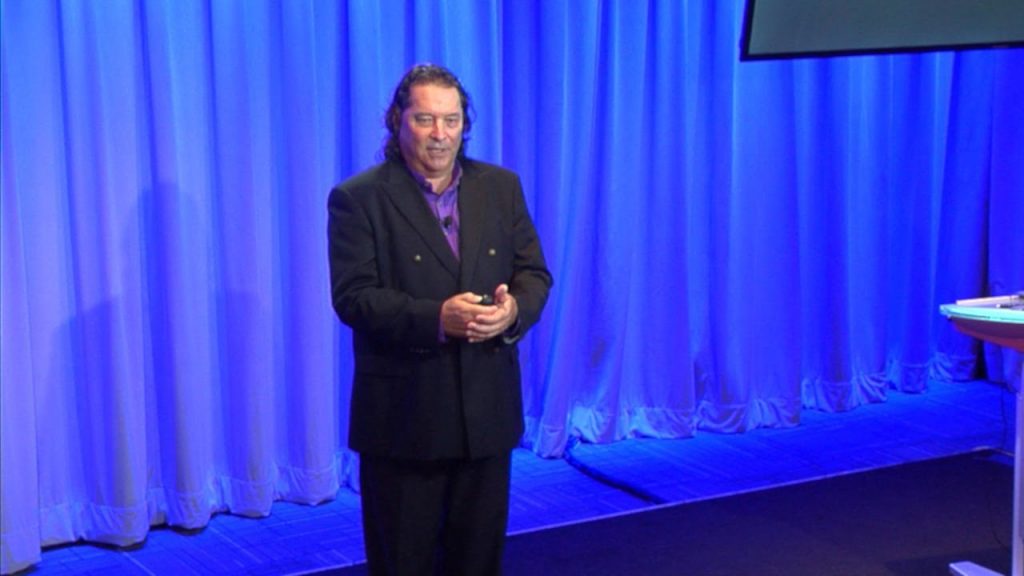
ILTF President Cris Stainbrook participates in acclaimed Talks at Google series
Sept. 20, 2018
The world’s most influential thinkers, creators, makers and doers share their insights as part of the acclaimed ‘Talks at Google’ series. Cris Stainbrook, President of Indian Land Tenure Foundation and a thought leader on the history and future of American Indian lands, took part in the series recently with his presentation, “Indian Land: The Lasting Legacy of Manifest Destiny.” Stainbrook discussed how U.S. history has shaped Indian policy and led to the fractured state of Indian land tenure today, and shared the Foundation’s vision for the future of Indian land.
Talks at Google is a regular speaker series held at company offices around the world primarily for the benefit of Google’s 85,000 employees. Talks are also available on YouTube so that they are universally accessible by anyone who is interested. The series began more than 12 years ago and there have been over 4,000 talks since then. The initial presenters were employees (so-called “Googlers”) but then expanded to include authors and experts from around the world from a variety of different backgrounds.
“It was an honor to be invited to participate,” Stainbrook said. “It was also an excellent opportunity to share the history of Indian lands, as well as the Foundation’s role in influencing the future. Clearly, this is an audience of educated, intelligent leaders who can now share more knowledge about Indian Country with those around them.”
Watch Cris Stainbrook’s presentation
—————————
Elk River Law Office to host AIPRA seminar July 24-26 in Billings
July 6, 2018
The Elk River Law Office, which has more than 28 years of combined experience in federal Indian law, will be hosting a three-day training session on the American Indian Probate Reform Act (AIPRA) July 24-26, 2018 in Billings, Montana. Training will be held from 9:00 a.m. to 4:30 p.m. daily. The topics to be covered include:
- History of Indian title and ownership
- Legislative efforts to address fractionation
- Why AIPRA was enacted
- Inheritance rules for trust land ownership
- Specific AIPRA terms
- Single heir rule
- Impacts of AIPRA on LTRO
- Land record keeping before and after AIPRA
- Will drafting issues
- Impact of AIPRA on other trust transactions and practices
PRESENTERS
Majel M. Russell Esq., Elk River Law Office PLLP – Majel Russell was raised on the Crow Indian Reservation and is an enrolled member of the Crow Tribe. Ms. Russell graduated from the University of Montana School of Law in 1992 and is a founding partner in the law firm. She practices primarily federal Indian law representing tribes and tribal entities and litigates matters involving tribal jurisdiction, authorities, Indian businesses, school districts and civil litigation in Federal, State and Tribal Courts. Ms. Russell has also served as Principal Deputy Assistant Secretary of Indian Affairs in Washington, D.C. where she gained experience working with federal budget priorities, policies and regulations developing strategies for overcoming bureaucratic obstacles.
Clark Madison, former Regional Realty Officer, DOI, BIA – Clark Madison is an enrolled member of the Assiniboine and Sioux Tribe(s) of the Fort Peck Indian Reservation and a graduate of Montana State University-Billings. Mr. Madison, now retired from the Bureau of Indian Affairs, was the Regional Realty Officer in the Rocky Mountain Region for the last 19 years of his career. Mr. Madison was a member of the national American Indian Probate Reform Act (AIPRA) team that provided training to regional BIA staff, Land Titles and Records Offices, and BIA agency staff regarding AIPRA. Mr. Madison also participated in developing regulations for Title 25 of the Code of Federal Regulations, including surface leasing, conveyances, easements and land records. Mr. Madison has vast experience dealing with trust land transactions and a unique insight into the impact AIPRA has had on regulatory procedures.
REGISTRATION
Course registration fee is $800. For more information, please contact Stephanie Harris at Elk River Law Office by email (sharris@elkriverlaw.com) or telephone (406-259-8611).
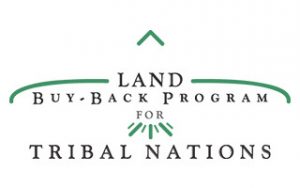
Landowners with Fractional Interests at Umatilla Receive Buy-Back Program Offers
Interested sellers have until August 14, 2018 to respond
June 19, 2018
WASHINGTON – The Department of the Interior announced today that more than 2,000 landowners with fractional interests at the Confederated Tribes of the Umatilla Indian Reservation in Oregon have been sent purchase offers from the Land Buy-Back Program for Tribal Nations.
The Buy-Back Program implements the land consolidation component of the Cobell Settlement, which provided $1.9 billion to consolidate fractional interests in trust or restricted land within a 10-year period set to expire in November 2022.
As a result of the Buy-Back Program, tribal ownership now exceeds 50 percent in more than 27,000 tracts of land (representing an increase of approximately 120 percent for the locations where implementation has occurred), strengthening tribal sovereignty and self-determination. Since the Program began making offers in December 2013, more than 762,000 fractional interests and the equivalent of nearly 2.2 million acres of land has been transferred to tribal governments. To date, the Program has made nearly 240,000 offers to Indian landowners.
“The Buy-Back Program provides a range of benefits – to landowners, to tribal nations, and to local communities,” said Program Director John McClanahan. “Landowners receive fair market value payments for voluntarily transferring their interests, which are immediately held in trust for the Tribe, preventing further fractionation. In addition, the strong communication and cooperation among various Interior and Umatilla Tribal staff has produced greater opportunities and new resources for landowners. Their efforts to share appraisal information for possible co-owner purchases represent a positive step toward leveraging the Program’s funding to achieve the Settlement’s goal of consolidating fractionated land.”
“The Umatilla Tribe is pleased to be working again with the Buy-Back Program to achieve our mutual goals,” said Bill Tovey, the Umatilla Tribes’ Director of Economic and Community Development. “In anticipation of the Buy-Back Program’s implementation and appraisals, the Umatilla Tribe has partnered with the Indian Land Capital Company (ILCC) to make available loans funded by the U.S. Department of Agriculture (USDA) to individual Umatilla members who want to obtain a controlling interest within their allotments for farming or ranching operations. The collaborative efforts involving the Umatilla Tribe, ILCC, and the Buy-Back Program demonstrate a multi-pronged approach to addressing fractionation at Umatilla.”
Landowners with fractional interests at the Umatilla Indian Reservation have until August 14, 2018, to consider and return accepted offers in the pre-paid postage envelopes provided.
Various informational tools are available to landowners, who are encouraged to think strategically about their options and carefully consider how to use the funds they receive from selling their land. Detailed frequently asked questions are available at https://www.doi.gov/buybackprogram/FAQ and additional information to help individuals make informed decisions about their land can be accessed at https://www.doi.gov/buybackprogram/landowners/informeddecisionmaking
Landowners also can contact the Trust Beneficiary Call Center at 888-678-6836 or visit their local Office of the Special Trustee for American Indians to ask questions about their land or purchase offers, request a copy of the appraisal completed for their land, and learn about financial planning.
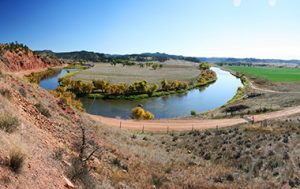
More than 10,000 California students will learn about Native American land, history and culture thanks to a grant from the San Manuel Band of Mission Indians
January 4, 2018
ST. PAUL, MINN. – More than 10,000 California students will learn about Native American land, history and culture over the next three years thanks to the partnership of San Manuel Band of Mission Indians in Highland, Calif. near San Bernardino, and the Indian Land Tenure Foundation (ILTF) in St. Paul, Minn. The Tribe has made a $471,062 grant to ILTF to expand the use of its Lessons of Our Land curriculum to 300 more California schools. The grant will enable ILTF, in collaboration with local school districts, to provide on-site training to more than 350 California teachers, as well as develop a new website and mobile application that offers easier access to lessons, and ongoing professional development for educators.
“Lessons of Our Land is making a huge impact in schools across the country, but this grant will enable us to do so much more in California,” said ILTF Program Officer Nichlas Emmons, who manages the program. “It’s important for all students – Native and non-Native alike – to understand American Indian land history and the impact it has had on this country.”
The Indian Land Tenure Foundation (ILTF) is a national, community-based organization serving American Indian nations and their citizens in the recovery and control of their rightful homelands. ILTF works to promote education, increase cultural awareness, create economic opportunity, and reform the legal and administrative systems that prevent Indian people from owning and controlling reservation lands. Lessons of Our Land is an interdisciplinary curriculum developed by ILTF that enables Pre-K through grade 12 teachers to easily incorporate Native American stories, lessons and games about land, cultures, histories and languages into regular classroom instruction while meeting state and federal educational standards.
“The goal is to give teachers and students broader insight and understanding of land, cultures, inherent rights and tribal sovereignty,” Emmons explained. “The larger goal is that every American citizen will identify with the land they live on and be better prepared to solve difficult issues that impact our communities.”
The new Lessons of Our Land website was recently launched. Teacher training will begin later this year. The San Manuel Tribe is committed to education and has a long history of supporting projects that share the history, culture and knowledge of Native communities. The Tribe is pleased to partner with ILTF to help more California students learn these important lessons.
More information on the curriculum is available at lessonsofourland.org.
About the San Manuel Band of Mission Indians
The San Manuel Band of Mission Indians is a federally recognized American Indian tribe located near Highland, Calif. The Serrano Indians are the indigenous people of the San Bernardino highlands, passes, valleys and mountains who share a common language and culture. The San Manuel reservation was established in 1891, and is recognized as a sovereign nation with the right of self-government. Like other governments, it seeks to provide a better quality of life for its citizens by building infrastructure, maintaining civil services and prompting social, economic and cultural development. (sanmanuel-nsn.gov)

Bush Foundation Grant Supports Organizations Helping Native Nations Recover Land
August 1, 2017
The Indian Land Tenure Foundation (ILTF) is a national, community-based organization that works with American Indian tribes and organizations that support Native nations and people in the recovery of their rightful homelands. Thanks to a $200,000 Ecosystem grant from the Bush Foundation, ILTF will be able to financially support several American Indian start-up organizations that are helping to return Indian lands to Indian hands.
The Bush Foundation provides Ecosystem grants to help sustain organizations such as ILTF that create unique and significant value by providing critical data and analysis, spreading great ideas and building capacity, advancing public awareness and policy, and building and supporting leadership networks. Established in 1953 by 3M executive Archibald Bush and his wife Edyth, the Foundation invests in great ideas and the people who power them. Inspired by the Bushes’ desire to build their community and encourage innovation, the Foundation has invested nearly one billion dollars in grants to thousands of organizations and individuals.
“ILTF is helping tribes rebuild and strengthen their land base so that full ownership and control of Indian land returns to, and remains in, Indian hands,” said ILTF President Cris Stainbrook. “This grant will allow us to help many small, regional organizations that are doing good work toward this goal.”
Through a variety of innovative programs and initiatives, ILTF works to promote education, increase cultural awareness, create economic opportunity, and reform the legal and administrative systems that prevent Indian people from owning and controlling reservation lands. As a community foundation, ILTF accepts contributions from foundations, tribes, corporations, organizations and individuals to support its grant making and program initiatives. Since its inception in 2002, ILTF has provided more than $40 million in grants, loans and program services throughout the nation in support of Indian land recovery and management efforts. ILTF has a variety of innovative programs and grants, including:
- Estate Planning – Providing education and estate planning services for tribal members as a way to stop the continued division of Indian land titles, and to ensure that Indian lands are controlled and managed by Indian people.
- National Tribal Land Association (NTLA) – Professional association for tribal land and natural resources staff to learn, share and network with their colleagues from other tribes. (ntla.info)
- The Tanka Fund – National campaign to bring renewed health and opportunity to American Indian communities through buffalo restoration, promoting healthy lands, healthy people and healthy economies. (tankafund.org)
- Spirit of Sovereignty – A National Indian Gaming Association-advised fund at ILTF that makes the opportunity for higher education a reality for Native American students by providing scholarships to attend tribal college. (spiritofsov.org)
- Lessons of Our Land – Pre-K through grade 12 curriculum that enables teachers to easily incorporate Native American stories, lessons and games about land, cultures, histories and languages into regular classroom instruction. (lessonsofourland.org)
“The Bush Foundation has been a great supporter of helping Native nations implement positive change,” Stainbrook said. “They understand the importance of nurturing start-up organizations that can make a significant difference in Indian Country, and we are pleased to help them do that. It is also gratifying to be recognized by the Indian community as a trusted source of information and assistance. ”
About the Bush Foundation – Established in 1953 by 3M executive Archibald Bush and his wife Edyth, the Bush Foundation invests in great ideas and the people who power them. Inspired by the Bushes’ desire to build their community and encourage innovation, the Foundation has invested nearly one billion dollars in grants to thousands of organizations and individuals. (bushfoundation.org)
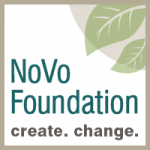
NoVo Foundation Grant Supports American Indian Land Recovery and Management
July 12, 2017
Land has never been more important for American Indian people as they pursue economic development, financial independence, and the preservation of their culture and history, and the Indian Land Tenure Foundation (ILTF) is committed to serving Native nations and their citizens in the recovery and control of their rightful homelands. Thanks to a $1.5 million operating grant from the NoVo Foundation, ILTF will be able to continue its innovative programs and initiatives that are helping return Indian lands to Indian hands.
“The Foundation’s goal is a large one, and it’s going to take a very long time to accomplish,” said ILTF President Cris Stainbrook. “This grant from the NoVo Foundation will enable us to provide more support and services to Native nations and individual Indian landowners as we work toward that end.”
The NoVo Foundation is dedicated to building a more just and balanced world. Founded in 2006 by Jennifer and Peter Buffett, NoVo has become one of the largest private foundations in the world to support Indigenous communities and organizations in North America as they determine their own priorities for the future.
ILTF is a national, community-based organization that works to promote education, increase cultural awareness, create economic opportunity, and reform the legal and administrative systems that prevent Indian people from owning and controlling reservation lands. As a community foundation, ILTF accepts contributions from foundations, tribes, corporations, organizations and individuals to support its grant making and program initiatives.
Since its inception in 2002, ILTF has provided more than $40 million in grants, loans and program services in support of Indian land recovery and management. The Foundation makes a positive impact on the lives of Native Americans through a variety of innovative programs and grants, including:
- Estate Planning – Providing education and estate planning services for tribal members as a way to stop the continued division of Indian land titles, and to ensure that Indian lands are controlled and managed by Indian people.
- National Tribal Land Association (NTLA) – Professional association for tribal land and natural resources staff to learn, share and network with their colleagues from other tribes.
- The Tanka Fund – National campaign to bring renewed health and opportunity to American Indian communities through buffalo restoration, promoting healthy lands, healthy people and healthy economies.
- Spirit of Sovereignty – A National Indian Gaming Association-advised fund at ILTF that makes the opportunity for higher education a reality for Native American students by providing scholarships to attend tribal college.
- Lessons of Our Land – Pre-K through grade 12 curriculum that enables teachers to easily incorporate Native American stories, lessons and games about land, cultures, histories and languages into regular classroom instruction.
“Despite the many challenges, Indian nations are gradually regaining control over their homelands. ILTF’s role is to provide the tools and resources to help them do that,” Stainbrook said. “We are making an impact in Indian Country thanks to the support of foundations like NoVo, and the many individuals who believe in our mission.”
About the NoVo Foundation – The NoVo Foundation is dedicated to building a more just and balanced world. Founded in 2006 by Jennifer and Peter Buffett, NoVo supports Indigenous communities and organizations in North America as they determine their own priorities for the future; works to end violence and discrimination against girls and women; advances social and emotional learning in schools; and promotes healthy and sustainable communities. (novofoundation.org)
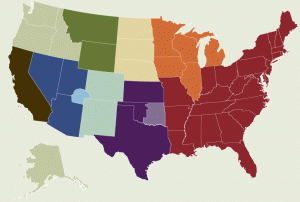
BIA Tribal Leaders Directory Map
July 7, 2016
Developed by the Bureau of Indian Affairs (BIA) as an interactive reference tool for its employees, the Tribal Leaders Directory map is now widely used by government, news media, business, researchers, and the public as a resource to help guide communication in Indian Country.
On Tuesday, Sept. 15, 2015, the U.S. Department of Agriculture announced the Indian Land Tenure Foundation as one of its 2015 Conservation Innovation Grant award recipients. The grant will utilize its National Indian Carbon Coalition (NICC) program to develop environmental markets in Indian Country involving rangeland management and several different Native nations. Learn more about the project on the NICC website at indiancarbon.org.
Free Land Management and Economic Development Training in August 2015
July 29, 2015
Indian Land Tenure Foundation will be offering more free landowner training in August. We are hosting several upcoming free training sessions for Native American landowners and agricultural producers in South Dakota, Nebraska and Wisconsin. The training is free to anyone who would like to attend and includes lunch and refreshments. For more information, please contact Jim Wabindato (jwabindato@iltf.org or 651-766-8999) at ILTF.
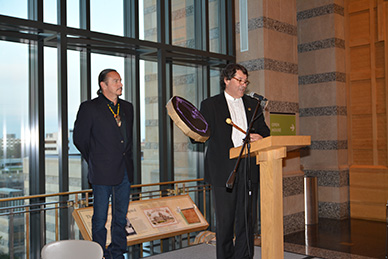
Indian Land Recovery Celebration
April 23, 2015
In a special ceremony held at the Minnesota History Center in St. Paul, the Indian Land Tenure Foundation was pleased to honor the Lakota, Dakota and Nakota tribes whose efforts resulted in saving and protecting the Pe’ Sla sacred site located in the Black Hills of South Dakota.
Watch a slideshow of the celebration.
Learn more about Pe’ Sla.
Events
2017 Tribal Land Staff National Conference Record Breaking Year
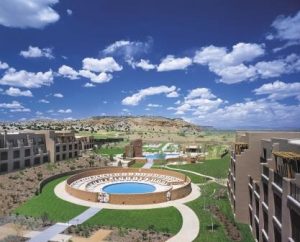
The 7th Tribal Land Staff National Conference was held at the Hyatt Regency Tamaya Resort and Spa, Santa Ana Pueblo, New Mexico March 21-23, 2017. It was a record-breaking year with 344 attendees, representing 91 federally recognized tribes. Participants were able to learn, share and network with other tribal land staff professionals during conference sessions, and networking breaks.
This year’s theme focused on advancing sovereignty and self-determination through tribal land management. Attendees had the opportunity to choose from numerous sessions, including topics focusing on Land and Reality Offices, Cultural and Environmental, and Advancing Sovereignty and Self-Determination. Materials from the conference are available to tribal land professionals on the Indian Land Forum Website.
Learn more about the 2017 Tribal Land Staff National Conference at ntla.info/
The 8th Tribal Land Staff National Conference will be held in 2018 in Tulsa, Okla. Learn more about this event at ntla.info/events.
ILTF in the News
How to make millions while saving a forest
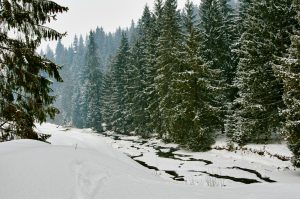
From Outside Magazine – May 7, 2018
By Jake Bullinger
The Sealaska Corporation is a for-profit company collectively owned by some 23,000 Native Alaskans from the Haida, Tlingit, and Tsimshian tribes. Since its creation in the 1970s, the company has made much of its money by logging in Alaska’s southeast islands. But beginning this year, that equation will flip: Sealaska stands to earn millions by leaving trees alone. In March, Sealaska received approval to participate in California’s cap-and-trade marketplace. That means the corporation will preserve 165,000 acres—45 percent of the forestland it controls—for 110 years to serve as a carbon sequestration bank. In return, Sealaska can sell carbon-offset credits to California companies that must curb their emissions under state law.
For now, investing in the carbon-offset market has been restricted to privately held land, which is why tribes and Native corporations like Sealaska have become such big players: They control a lot of forestland. In all, at least nine Native groups, from the Nez Perce in Idaho to the White Mountain Apache in Arizona, have invested in forest-based carbon-offset projects. Conservationists are keeping an eye on their success, because, if done right, it could also revolutionize the way companies profit on public land leases.
“We believe that it fits perfectly with our balanced land-management approach,” says Sealaska CEO Anthony Mallott. “We keep every acre with the foremost thought of best use in a community, cultural, and financial framework. Carbon was the perfect opportunity.”
California’s cap-and-trade program, which kicked off in 2013, promises to cut emissions in the state 40 percent by 2030. It will achieve this, in part, by setting pollution limits for certain industries and by requiring those that exceed the limits to invest in programs that offset their pollution, like carbon-trapping forests. Sealaska’s carbon-offsetting investment is expected to offset 11 million metric tons of carbon—the amount that 2.36 million cars emit in a year. With current offset prices at about $12 per ton, the credits could generate more than $100 million in revenue. No commercial logging will take place there, but that’s not to say the forest will remain untouched. Mallott says Sealaska can still develop its subsurface rights and tourism projects—think trails or lodges—and tribal members will be allowed to cut trees for totems, canoe construction, and other cultural uses.
“It’s another revenue stream that tribes are able to develop within their current conservation practices,” says Bryan Van Stippen, whose Minnesota-based National Indian Carbon Coalition advises tribes seeking to join carbon markets. “To me, it’s a win-win for everybody.”
It’s fitting that tribes and Native corporations are readily considering offsets. It wasn’t until the 1970s when most tribes were granted control of their forestland, and ever since they have been heralded for their resilient forestry practices. Some tribes sign on to these carbon-offset programs to preserve cultural resources, while others might do so purely to monetize land that’s less ideal for timber harvest—in fact, most tribes in the carbon market have maintained their logging operations, and instead of clear-cutting forests, they selectively harvest trees. For example, tribes could wait 60 years instead of 45 to cut second-growth trees, allowing more carbon to be stored before a tree is cut.
“Commercial logging operations are still able to operate with sustainable management practices,” says Van Stippen, adding that Sealaska and the other tribes around the country that are investing in carbon offsets are “maybe changing a few of their practices but are not putting a hindrance on their commercial operation.”
This system, so far, has been kept to privately owned forests. But the idea of leasing publicly owned land for carbon banks is gaining attention from researchers. Under the current system, forestland leaseholders turn a profit by cutting and selling trees. But what if companies could bid on leases with the idea of conserving the land as a carbon bank? It might actually be more profitable than doing so on private land, because federal leases present a relatively low-cost option on a massive scale. There is plenty of potential for national forests to act as a carbon sink, and according to the U.S. Forest Service, America’s public forests already offset 16 percent of our annual carbon emissions.
It’s not illegal to lease land for carbon sequestration. There just hasn’t been an executive order or any legislation that says you can do it. Because of that, most offset developers won’t consider projects on public land—yet. And all it might take is pressure from the private sector after they notice Sealaska and tribes turning big profits.
Carbon Credits Help Tribes Preserve Culture, Climate and Bottom Line
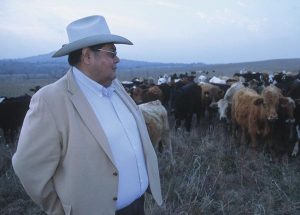
Feb. 16, 2016
The National Indian Carbon Coalition (NICC), a tribal non-profit, has received a three-year, $300,000 grant to improve access to carbon markets in Indian Country, enabling tribes to help mitigate climate change’s effects while improving their bottom line. “This is exciting for Indian Country,” said NICC Program Director Erick Giles, Muscogee (Creek) and a member of the Big Cat Clan. “Generating and selling carbon credits is a mostly untapped way for tribes to promote economic development on their reservations through resource management.”
Read the article at indiancountrytodaymedianetwork.com.
Photo courtesy of Comanche Nation
Bureau of Indian Affairs places sacred site in Black Hills in trust
March 17, 2016
The Bureau of Indian Affairs placed a sacred site in the Black Hills of South Dakota in trust.The Crow Creek Sioux Tribe, the Rosebud Sioux Tribe, the Shakopee Mdewakanton Sioux Community and the Standing Rock Sioux Tribe raised $9 million to purchase Pe’ Sla, a 2,022-acre site that plays a central role in Lakota history, culture and cosmology. The tribes celebrated after learning of the BIA’s March 10 decision.
Read more at indianz.com.
Columbia Heights Public Schools recognized by Indian Land Tenure Foundation

Oct. 31, 2015
A representative from the Indian Land Tenure Foundation publicly recognized Columbia Heights Public Schools for its work in incorporating the Lessons of Our Land curriculum across the school district. The curriculum incorporates Native American Stories and lessons into regular classroom instruction.
Nichlas Emmons, program and development officer for the Indian Land Tenure Foundation, spoke to the School Board during its Oct. 13 meeting as part of a presentation with teaching and learning leaders on the curriculum integration, and also to recognize the district for its efforts.
Read more at focus.mnsun.com.
Federal Testimony
Senate Committee Hearing on Status of Department of Interior Backlogs
May 22, 2008
Senate Committee Hearing on Status of Department of Interior Backlogs
May 7, 2003
Senate Bill: S.519, Native American Capital Formation and Economic Development Act
April 30, 2003
Success Stories
Through innovative programs, initiatives, and grants, ILTF is making a positive impact on the lives of Native Americans. These successes include:
- Assisting efforts by the Lakota, Dakota and Nakota people to purchase and protect more than 2,300 acres at the Pe’ Sla sacred site in South Dakota.
- Helping create the National Tribal Land Association (NTLA) to bring together land professionals from Native Nations who are working to preserve, protect, develop and manage Indian land.
- Establishing the National Indian Carbon Coalition (NICC) to help Native Nations enter the emerging carbon credit markets, earning valuable income while protecting precious natural resources.
- Creating strategic land planning and educational tools used by tribal land planners and real estate professionals.
Watch for new success stories as these are added.
Kashia Tribe recovers its Pacific Coast homeland
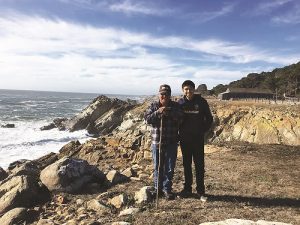
Nearly 150 years after being forcibly removed from their ancestral homelands to an inland reservation, the Kashia Band of Pomo Indians in Sonoma County, Calif., once again have access to the Pacific Ocean. On June 15, 2016, the Tribe celebrated the recovery of nearly 700 acres, a milestone made possible with the help of the Indian Land Tenure Foundation (ILTF) and its affiliate, the Indian Land Capital Company (ILCC).
“This acquisition would not have been possible without the assistance of ILTF and ILCC,” said Kashia Tribal Chairman Reno Keoni Franklin. “Not only did they play a major financial role in our acquisition of the property, they also provided valuable advice and were a strong voice of empowerment for us when we doubted if we could complete the purchase.”
ILCC extended a loan to Kashia in 2015 to purchase the land north of San Francisco, which features redwood forest, towering coastal bluffs and spectacular waterfalls. The Tribe has established the Kashia Coastal Reserve, a protected open space and demonstration forest to educate and engage the public about the history and practices of the Kashia people.
Learn more about success stories made possible with financing from Indian Land Capital Company at ilcc.net.
Tribe-specific Curriculum for Montana Schools
Montana state standards include the teaching of tribal sovereignty, and this curriculum is an excellent fit with our state efforts to include authentic American Indian content in all Montana classrooms. – Mike Jetty, Curriculum Specialist, Montana Office of Public Instruction
In 2008, Indian Land Tenure Foundation (ILTF) funded the adaptation of ILTF’s K-12 curriculum, Lessons of Our Land, to reflect Montana tribal histories and cultures and to implement the curriculum in classrooms state-wide.
Montana public schools educate nearly 150,000 students each year, with Indian students making up about 12 percent of the student population. Montana has been on the front line of an emerging trend in state legislatures’ and education departments’ mandatory inclusion of tribal histories and cultural components into classroom materials. In 1999, the Montana Legislature passed the Indian Education for All Act, requiring all public schools throughout the state to include coursework in the history and culture of Indian tribes in the state. Teachers in Montana now have a wealth of resources to incorporate Native American perspectives in classroom materials.
The newly adapted curriculum was developed through extensive research and interviews with tribal elders and historians from Montana’s 12 tribes who reside on seven reservations throughout the state. The resulting product is a rich and varied source of lesson plans and materials, including photographs, slideshows, maps and a Montana tribal lands jeopardy game. All of the lessons align with Montana’s state-wide content standards.
ILTF hopes that the curriculum adaptation and implementation in Montana will serve as a catalyst for other states, especially those with significant Indian populations. In 2007, South Dakota, where nine percent of the total population and more than 11 percent of public school students are Native American, passed an Indian Education Act to support existing statewide Indian education programs and provide teacher training. Despite this progress, the state has yet to pass a mandate similar to Montana’s. To help them move in that direction, in 2008, ILTF made a grant to South Dakota’s Office of Indian Education to support the development of state academic standards in American Indian history and culture for the state’s K-12 programs.
The Head Start and K-12 curriculum is free and available to all at lessonsofourland.org.